TENDA TECHNOLOGY 4G600 3G/4G Wireless N150 Router User Manual 2
SHENZHEN TENDA TECHNOLOGY CO., LTD. 3G/4G Wireless N150 Router 2
Contents
- 1. User Manual-1
- 2. User Manual-2
User Manual-2
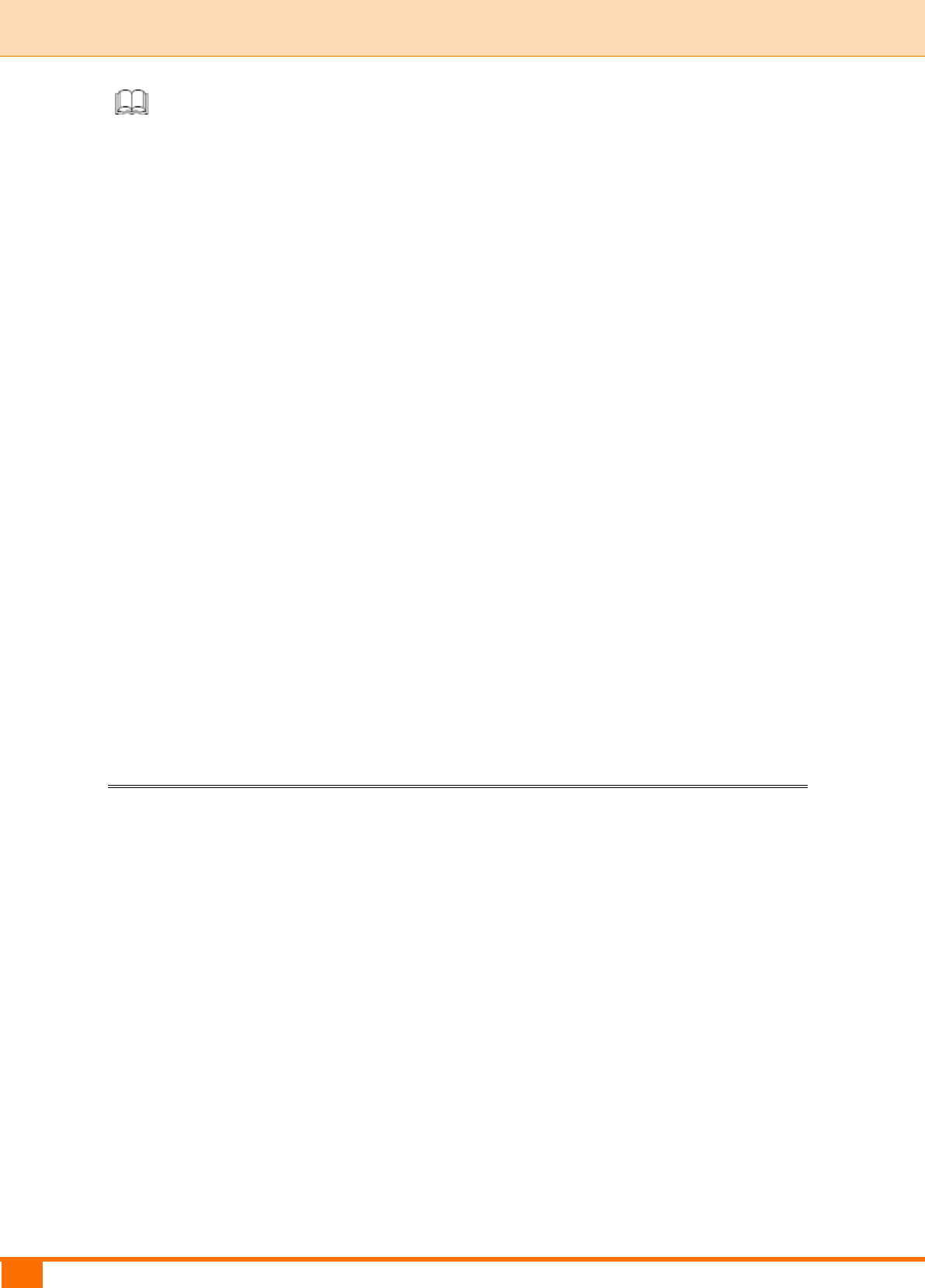
41
III Features & Configurations | Tenda
Knowledge Center
802.11 Mode: Select a correct network mode according to your wireless clients.
11b mode: This network mode delivers wireless speed up to 11Mbps
and is only compatible with 11b wireless clients.
11g mode: This network mode delivers wireless speed up to 54Mbps
and is only compatible with 11g wireless clients.
11b/g mixed mode: This network mode delivers wireless speed up to
54Mbps and is compatible with 11b/g wireless clients.
11b/g/n mixed mode: This network mode delivers wireless speed up to
300Mbps and is compatible with 11b/g/n wireless clients.
BSSID: This is the MAC address of the device's wireless interface.
SSID Broadcast: This option allows you to have your wireless network name
(SSID) publicly broadcast or if you choose to disable it, the SSID will be hidden.
Channel Bandwidth: Select a proper channel bandwidth to enhance wireless
performance. This option is available only in 802.11b/g/n mixed mode.
Maximum wireless speed in the channel bandwidth of 20/40 is 2 times in 20.
Extension Channel: This is used to ensure N speeds for 802.11n devices on
the network. This option is available only in 11b/g/n mixed mode with the
channel bandwidth of 20/40.
3.2 Security
Click Wireless -> Security to enter the configuration screen. Here you can
define a security key to secure your wireless network against unauthorized
accesses.

42
III Features & Configurations | Tenda
Configuration Procedures:
① Configure Security Mode, Cipher Type and Security Key.
② Click Save to save your settings.
Knowledge Center
WEP: WEP is intended to provide data confidentiality comparable to that of a
traditional wired network.
Open: If selected, wireless speed can reach up to 54Mbps.
Shared: If selected, wireless speed can reach up to 54Mbps.
Default Key: Select a key to be effective for the current WEP encryption. For
example, if you select Key 2, wireless clients must join your wireless network
using this Key 2.
WPA-PSK: WPA personal supports AES and TKIP cipher types.
WPA2-PSK: WPA2 personal supports AES, TKIP and TKIP+AES cipher types.
Mixed WPA/WPA2-PSK: If selected, both WPA-PSK and WPA2-PSK secured
wireless clients can join your wireless network.
AES: If selected, wireless speed can reach up to 300Mbps.
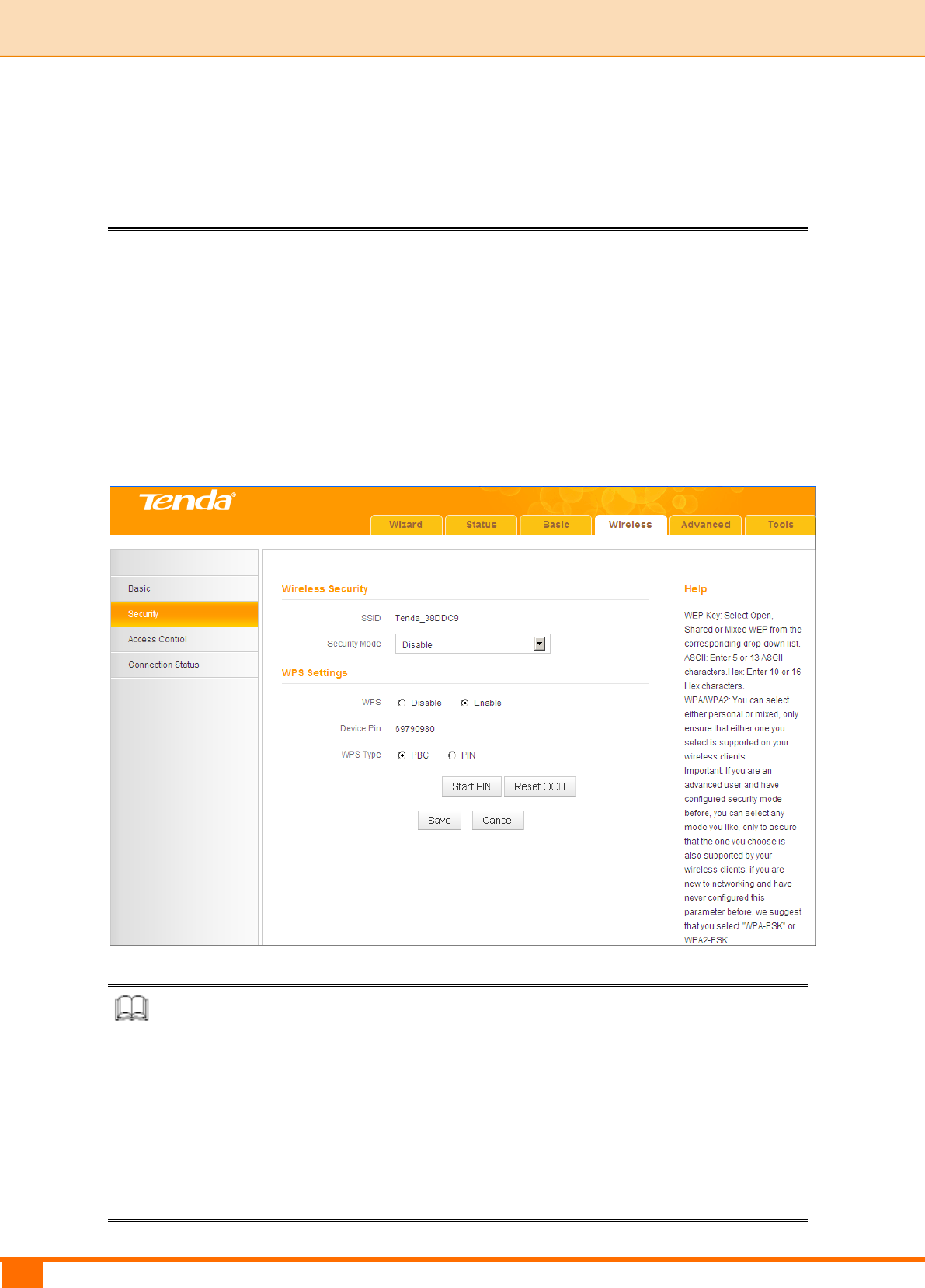
43
III Features & Configurations | Tenda
TKIP: If selected, wireless speed can reach up to 54Mbps.
TKIP&AES: If selected, both AES and TKIP secured wireless clients can join
your wireless network.
Key Renewal Interval: Enter a valid time period for the key to be changed.
WPS
Wi-Fi Protected Setup makes it easy for home users who know little of wireless
security to establish a home network, as well as to add new devices to an
existing network without entering long passphrases or configuring complicated
settings. Simply enter a PIN code or press the hardware WPS button and a
secure wireless connection is established.
Knowledge Center
WPS: Select Enable/Disable to enable/disable the WPS encryption.
WPS Type: Select PBC (Push-Button Configuration) or PIN.
Reset OOB: If clicked, the WPS LED will turn off and the security function will
be disabled automatically. The WPS server on the router enters idle mode and
will not respond to any client’s W PS connection request.

44
III Features & Configurations | Tenda
Device PIN: Displays the device’s PIN code.
Start PIN: If you enter the client’s PIN code on the router, clicking this button
starts the PIN connection.
Operation Instructions:
PBC: If you press the hardware WPS button on the device for 1 second, the
WPS LED will blink for about 2 minutes, indicating that the PBC encryption
method is successfully enabled. During this time, an authentication routine can
be performed between your device and a WPS/PBC capable wireless client.
Simply enable the WPS/PBC on the client wireless device. If it passes the
authentication, the wireless client device connects to your device and the WPS
LED turns off. Repeat the steps above if you want to add more wireless client
devices to your device.
PIN: To use this option, you must know the PIN code from the wireless client
and enter it in the corresponding field on your device while using the same PIN
code on the client side for this connection.
Note
① To use the WPS encryption, the wireless client device must also be
WPS-capable.
② The WPS becomes unavailable if you select any of the following option:
Open, Shared, WPA2-PSK plus TKIP, and Mixed WPA/WPA2-PSK plus
TKIP.
3.3 Access Control
Specify a list of devices to "Allow" or "Deny" a connection to your wireless
network via the devices’ MAC Addresses.
Click Wireless -> Access Control to enter the configuration screen. Three
options are available: Disable, Deny and Allow.
A. If you want to allow all wireless clients to join your wireless network, select
Disable.
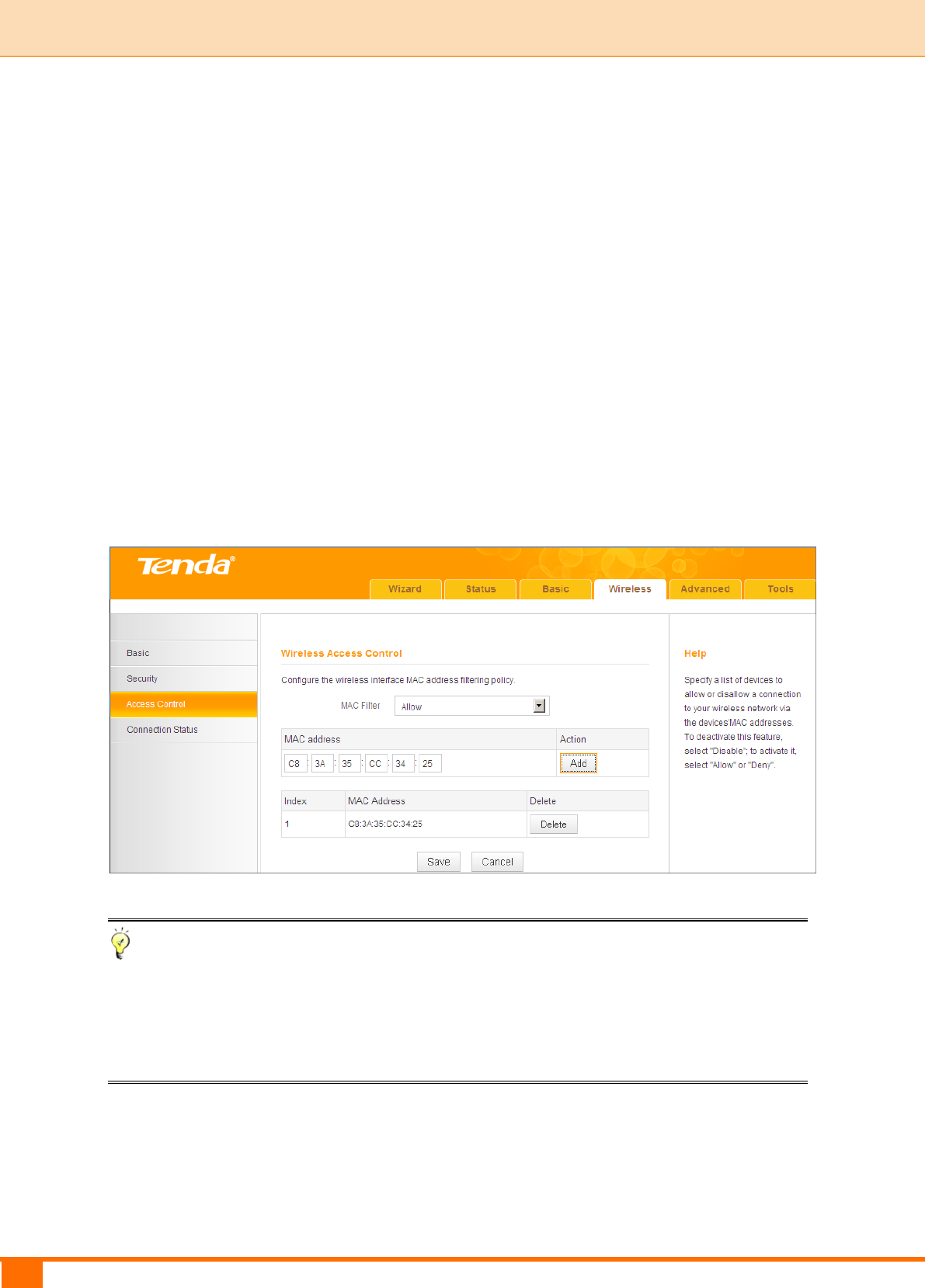
45
III Features & Configurations | Tenda
B. If you want to allow ONLY the specified wireless clients to join your wireless
network, select Allow.
C. If you want to disallow ONLY the specified wireless clients to join your
wireless network, select Deny.
Wireless Access Control Application Example:
To only allow your own notebook at the MAC address of C8:3A:35:CC:34:25 to
join your wireless network:
① Select Allow.
② Enter C8:3A:35:CC:34:25.
③ Click Add to add the MAC address to the MAC address list.
④ Click Save to save your settings.
Tip
If you don't want to configure the complex wireless security settings and want to
disallow others to join your wireless network, you can configure a wireless
access control rule to allow only your own wireless device.
3.4 Connection Status
Click Wireless -> Connection Status. Here you can see a list of wireless
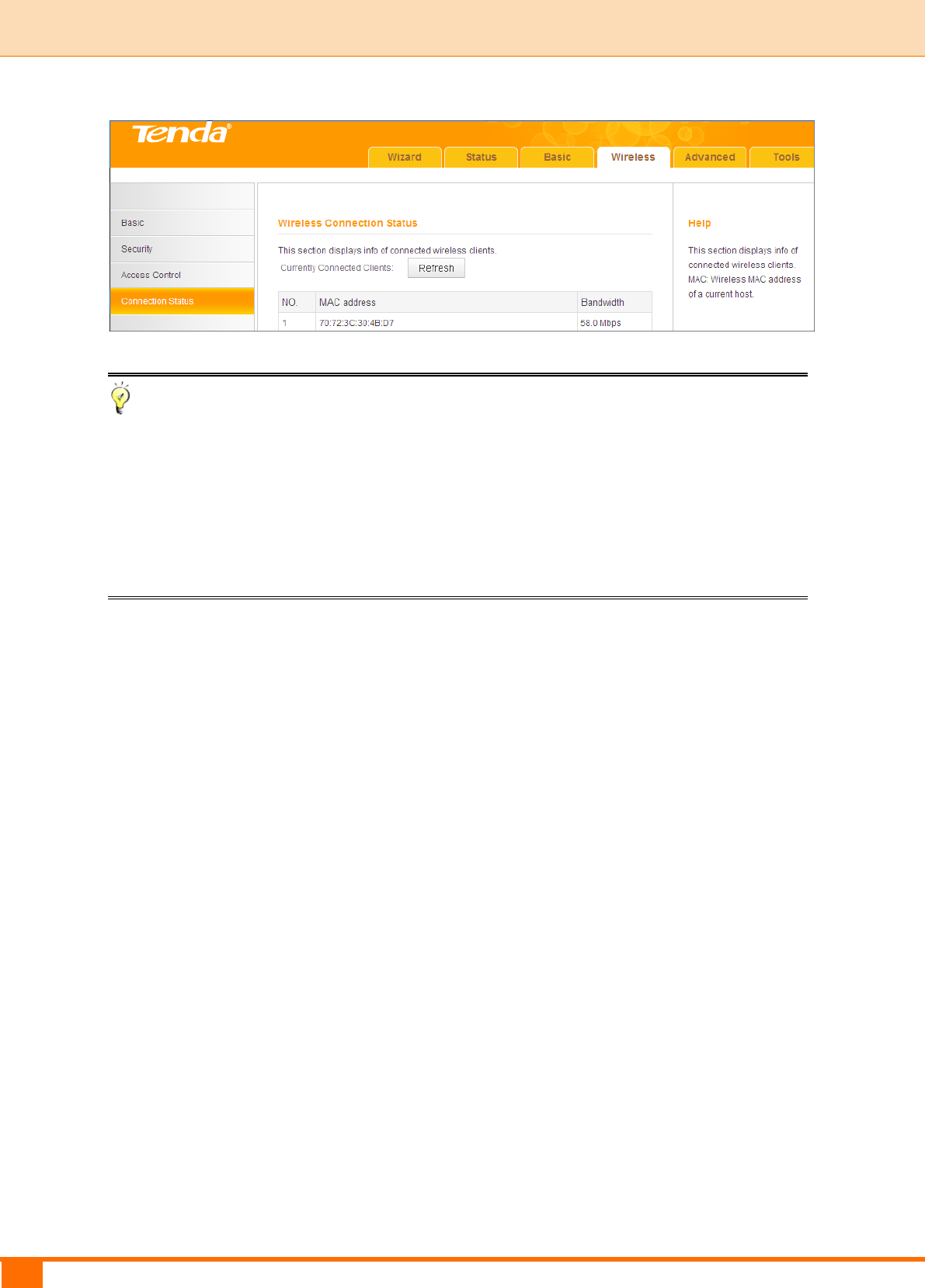
46
III Features & Configurations | Tenda
devices (if any) connected to the device.
Tip
① The Bandwidth here refers to the channel bandwidth instead of wireless
connection rate.
② You can know whether there are unauthorized accesses to your wireless
network by viewing this connection status list.
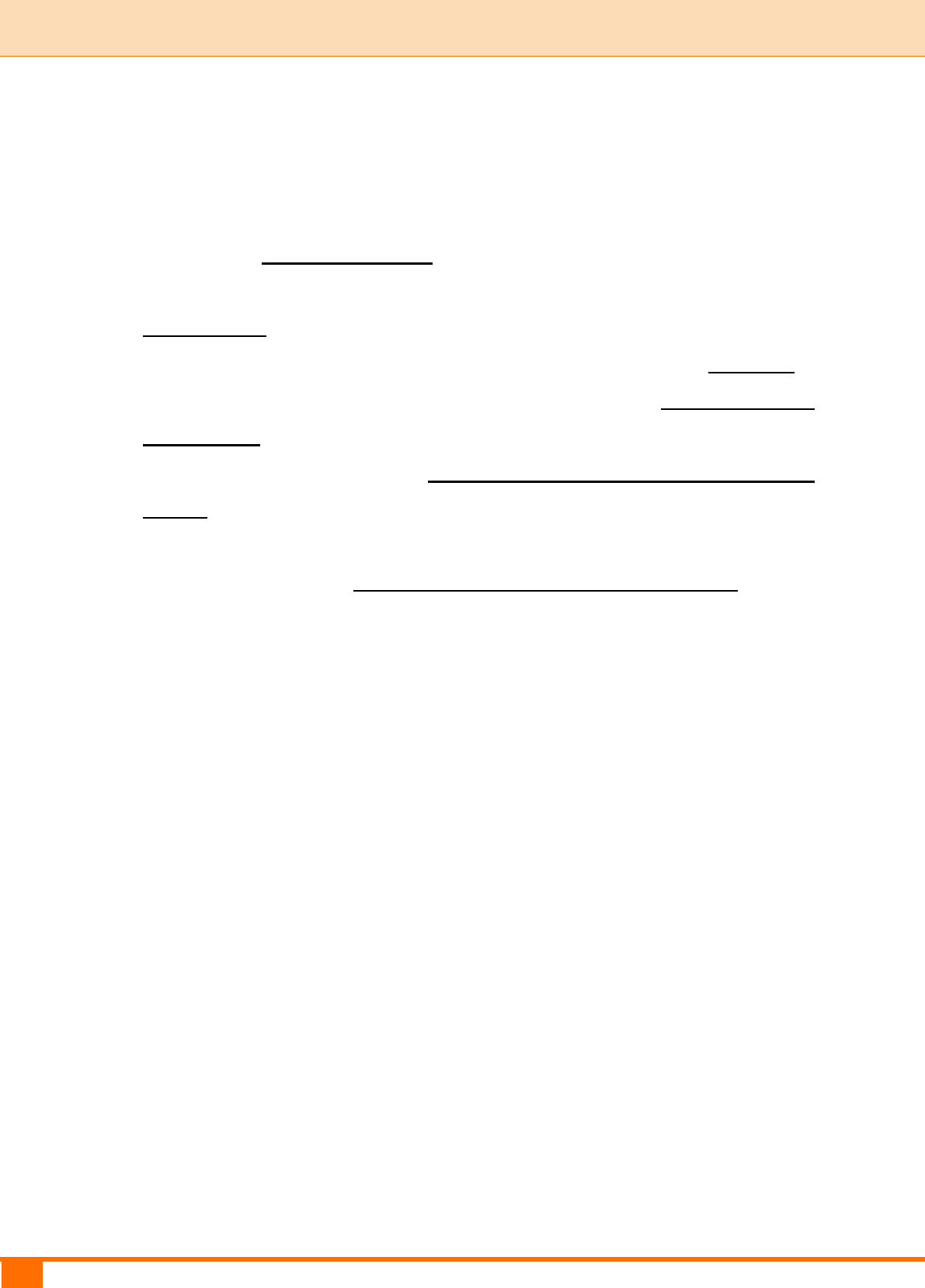
47
III Features & Configurations | Tenda
4 Advanced Applications
This section includes the following:
To remotely access the device via a domain name or access a server on a
LAN PC, see 4.1 DDNS Settings.
To let an Internet user access your LAN PC without any restriction, see
4.2 DMZ Host.
To automatically map the ports between WAN and LAN, see 4.3 UPNP.
To enable the remote Web management feature, see 4.4 Remote Web
Management.
To regulate bandwidth, see 4.5 Bandwidth Control (Available only in
4G600).
To restrict your LAN PCs to access certain services on the Internet via
their IP addresses, see 4.6 Client Filter (Available only in 4G600).
4.1 DDNS Settings
Dynamic DNS or DDNS is a term used for the updating in real time of Internet
Domain Name System (DNS) name servers. We use a numeric IP address
allocated by Internet Service Provider (ISP) to connect to the Internet; the
address may either be stable ("static"), or may change from one session on the
Internet to the next ("dynamic"). However, a numeric address is inconvenient to
remember; an address which changes unpredictably makes connection
impossible. The DDNS provider allocates a static host name to the user;
whenever the user is allocated a new IP address this is communicated to the
DDNS provider by software running on a computer or network device at that
address; the provider distributes the association between the host name and
the address to the Internet's DNS servers so that they may resolve DNS queries.
Thus, uninterrupted access to devices and services whose numeric IP address
may change is maintained.
Click Advanced -> DDNS Settings to enter the screen below.
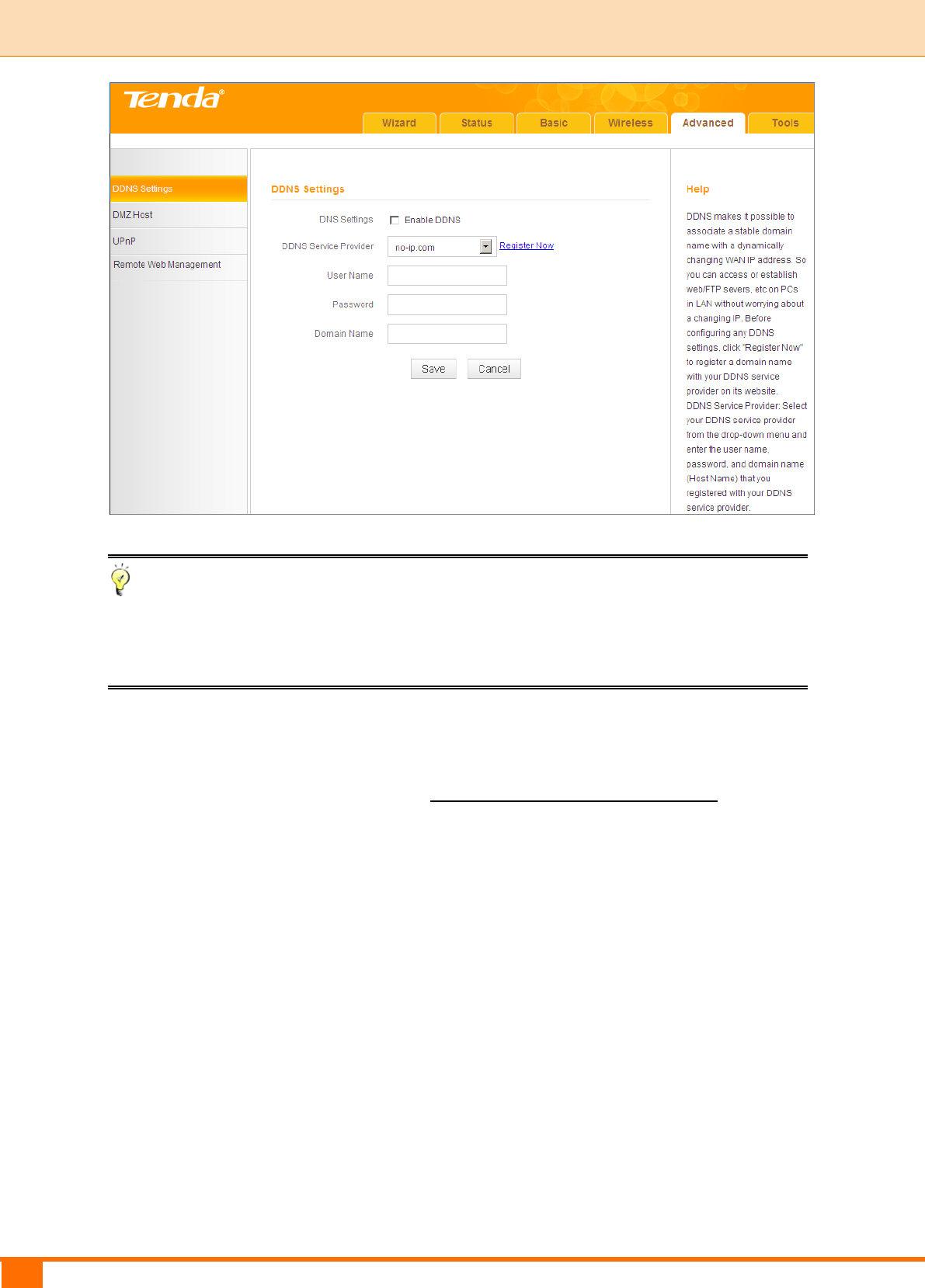
48
III Features & Configurations | Tenda
Tip
To use the DDNS feature, you need to have an account with one of the DDNS
Service Providers in the drop-down list first.
DDNS Application Example:
If your ISP gives you a dynamic (changing) public IP address, you want to
access your router remotely (see 4.4 Remote Web Management) but you
cannot predict what your router's WAN IP address will be, and the address can
change frequently. In this case, you can use a commercial Dynamic DNS service.
It lets you register your domain to their IP address and forwards traffic directed
at your domain to your frequently changing IP address.
If your DDNS service provider provides you with a DDNS account (User Name:
tenda, Password: 123456, Domain Name: tenda.dyndns.org) and you want to
use the PC at the IP address of 218.88.93.33 to remotely access this device on
the port number of 8090. Then follow the steps below:
① DDNS Settings: Check the Enable DDNS box.
② DDNS Service Provider: Select your DDNS service provider from the
drop-down list. Here in this example, select dyndns.org.
③ User Name: Enter the DDNS user name you have registered with your
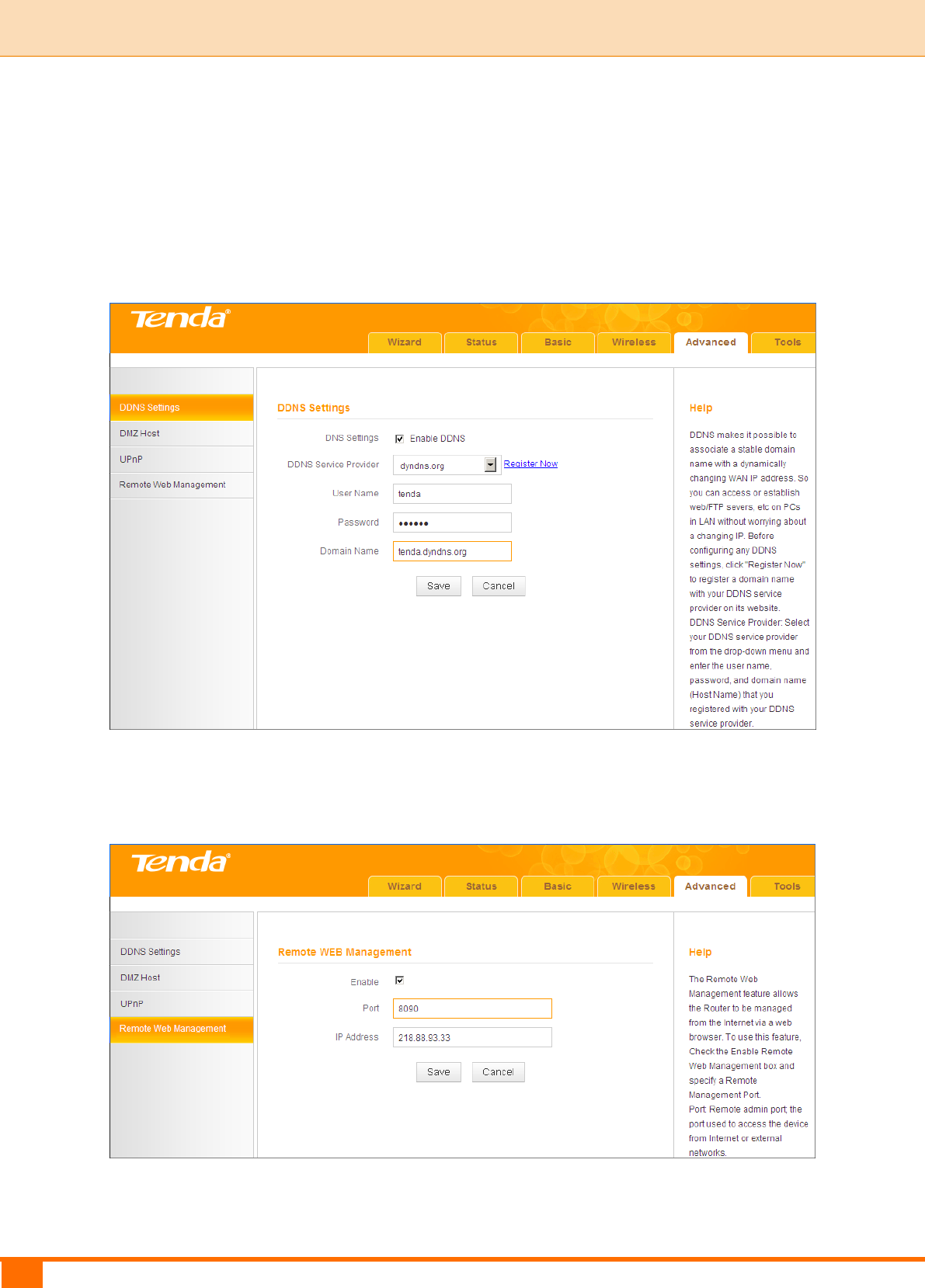
49
III Features & Configurations | Tenda
DDNS service provider. Here in this example, enter tenda.
④ Password: Enter the DDNS Password you have registered with your DDNS
service provider. Here in this example, enter 123456.
⑤ Domain Name: Enter the DDNS domain name you have registered with your
DDNS service provider. Here in this example, enter tenda.dyndns.org.
⑥ Click Save to save your settings.
⑦ Click Remote Web Management, enable the Remote Web Management
feature, enter 8090 in the Port field, 218.88.93.33 in the IP Address field and
then click Save to save your settings.
Now, you can access your device from the Internet by typing your device’s
domain name into your browser ’s address or location field on yo ur PC
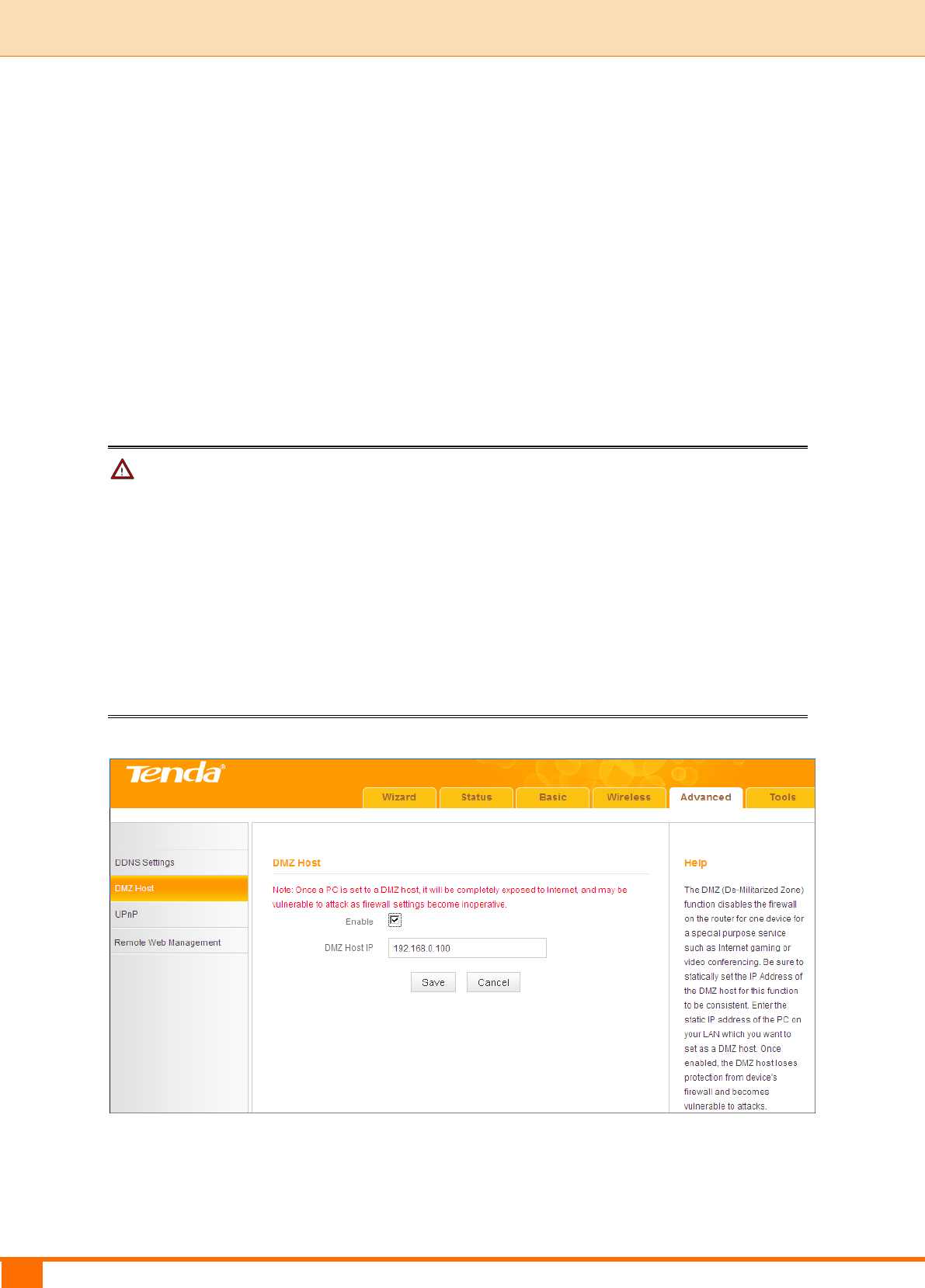
50
III Features & Configurations | Tenda
(218.88.93.33) followed by a colon (:) and the remote management port number.
Here in this example, enter http://tenda.dyndns.org:8090.
4.2 DMZ Host
The DMZ (De-Militarized Zone) function disables the firewall on the router for
one device for a special purpose service such as Internet gaming or video
conferencing applications that are not compatible with NAT (Network Address
Translation).
Click Advanced -> DMZ Host to enter the screen below.
Note
① DMZ host poses a security risk. A computer configured as the DMZ host
loses much of the protection of the firewall and becomes vulnerable to
attacks from external networks.
② Hackers may use the DMZ host computer to attack other computers on your
network.
Configuration Procedures:
① DMZ Host IP: The IP address of the device for which the router ’s firewall
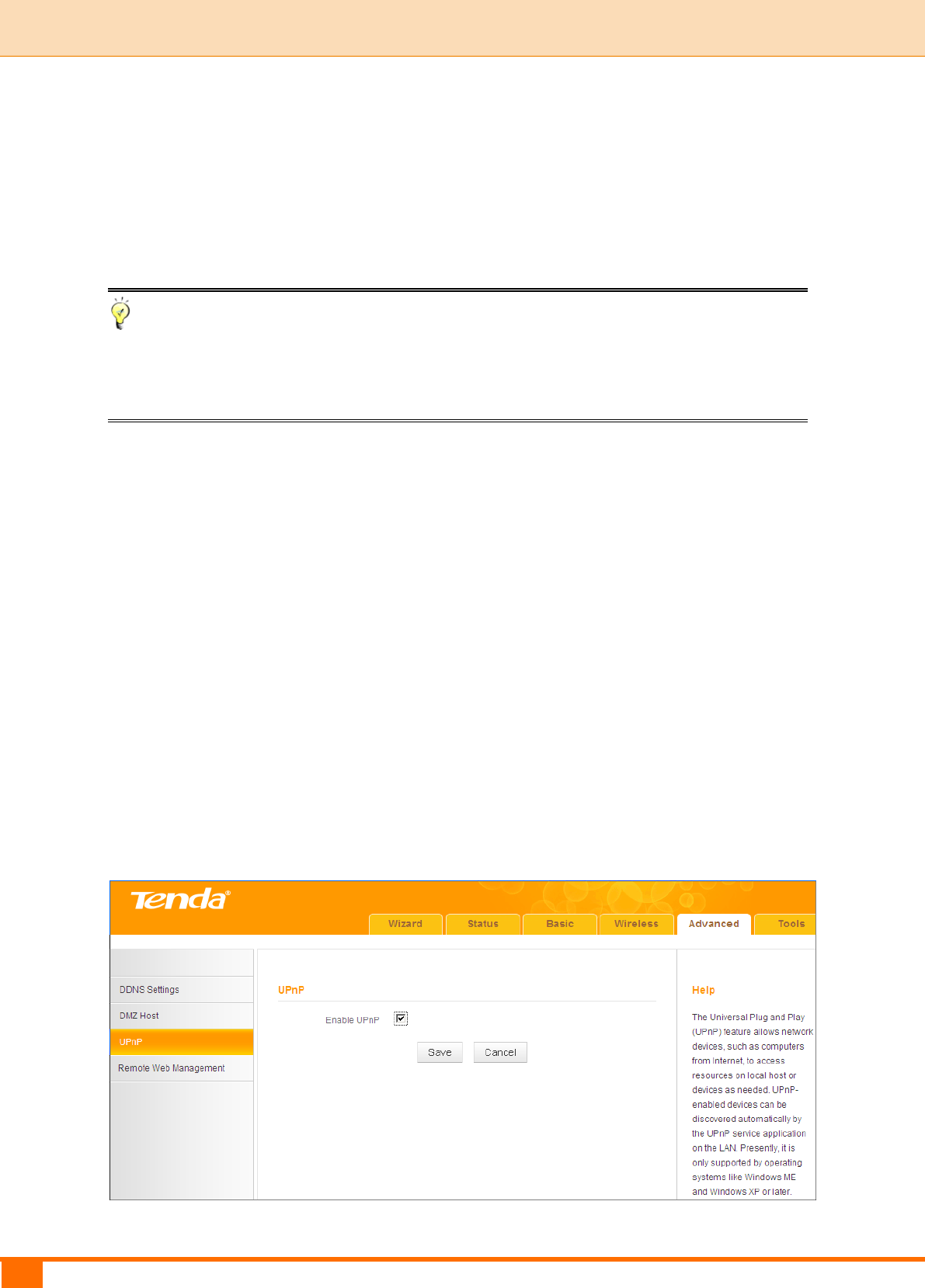
51
III Features & Configurations | Tenda
will be disabled. Be sure to statically set the IP address of the device that
serves as a DMZ host for this function to be consistent.
② Enable: Check to enable the DMZ host functionality.
③ Click Save to save your settings.
Tip
Security softwares such as anti-virus softwares and OS built-in firewall, etc.
may affect the DMZ host feature. Disable them if the DMZ host fails.
4.3 UPNP
The Universal Plug and Play (UPnP) feature allows network devices, such as
computers from the Internet, to access resources on local host or devices as
needed. UPnP-enabled devices can be discovered automatically by the UPnP
service application on the LAN. If you use applications such as multiplayer
gaming, peer-to-peer connections, real-time communications such as instant
messaging, or remote assistance (a feature in Windows XP), you may need to
enable Universal Plug and Play (UPnP) for better experience.
Click Advanced -> UPnP to enter the configuration screen. The UPnP feature is
enabled by default.
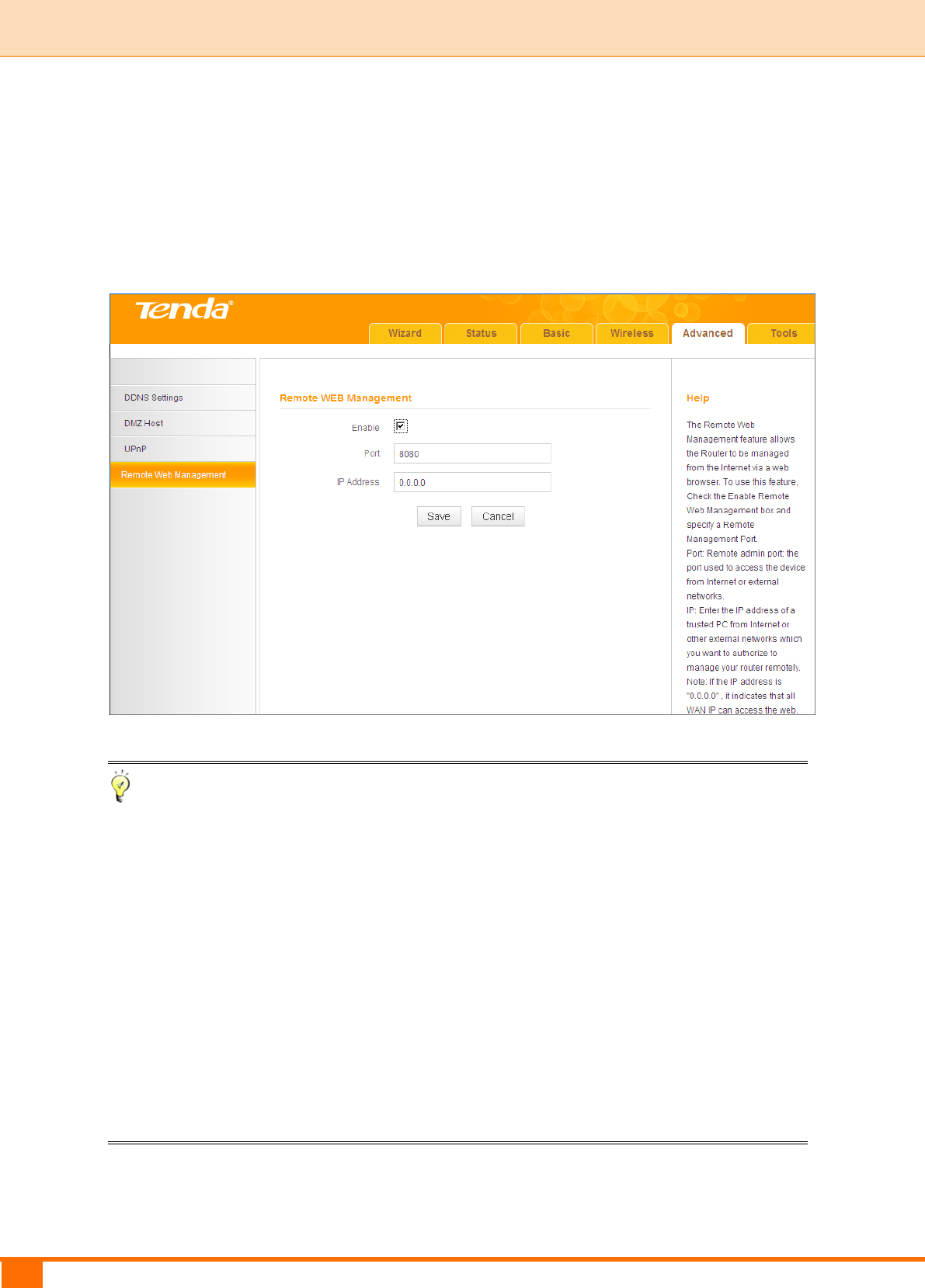
52
III Features & Configurations | Tenda
4.4 Remote Web Management
The Remote Web Management allows the device to be configured and managed
remotely from the Internet via a Web browser.
Click Advanced -> Remote Web Management to enter the configuration
screen.
Tip
① For better security, configure a port number (between 1025 and 65535) as
the remote Web management interface, do not use the number of any
common service port (1~1024).
② Make sure your WAN IP address (Internet IP address) is a public IP address.
Private IP addresses are not routed on the Internet.
③ It is unsafe to make your router remotely accessible to all PCs on external
network. For the purpose of security, we suggest that you only enter the IP
address of the PC that is to be used to remotely manage your device.
Remote Web Management Application Example:
To access your device (WAN IP address: 102.33.66.88) at your home from the

53
III Features & Configurations | Tenda
PC (218.88.93.33) at your office via the port number of 8090, follow the steps
below:
① Enable: Check to enable the remote Web management feature.
② Port: Enter 8090.
③ IP Address: Specify the IP address for remote management. Here in this
example, enter 218.88.93.33.
④ Click Save to save your settings.
Type "http://102.33.66.88:8090" into your browser’s address or location field
and you can remotely access the router from your home.
Knowledge Center
IP Address: Here you can specify the IP address for remote management (If set
to "0.0.0.0", the device becomes remotely accessible to all the PCs on the
Internet or other external networks).
Port: This is the management port to be open to outside access. The default
setting is 8080. This can be changed.
4.5 Bandwidth Control (Available only in 4G600)
If there are multiple PCs behind your device competing for limited bandwidth
resource, then you can use this feature to specify a reasonable amount of
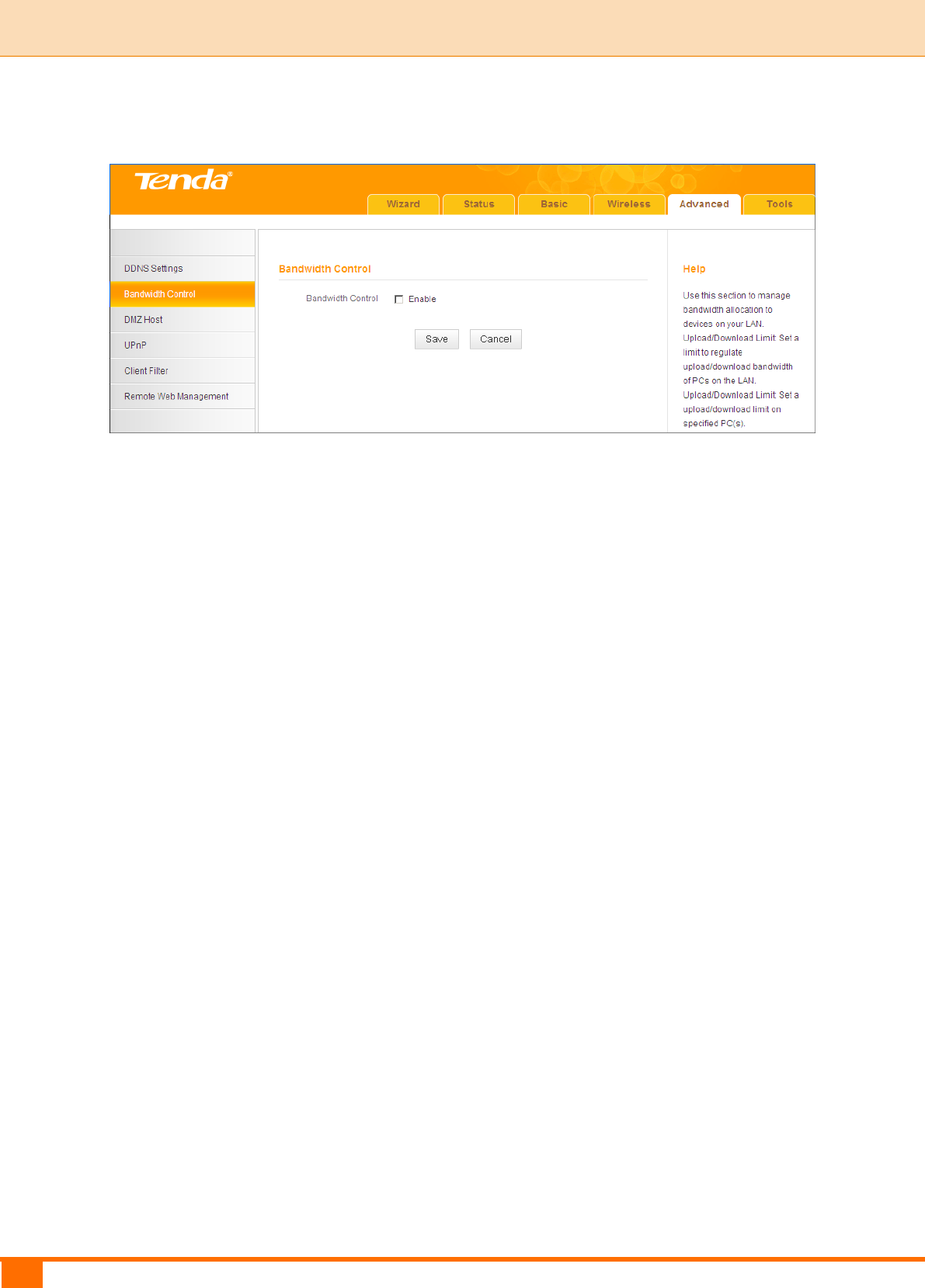
54
III Features & Configurations | Tenda
bandwidth for each such PC, so that no one will be over stuffed or starved to
death. Note that this feature is unavailable in 3G/4G Router Mode.
Bandwidth Control Application Example:
You share a 4M-broadband service with your neighbor (at the IP address of
192.168.0.125). He always downloads a large volume of data from the Internet,
which sharply frustrates your Internet surfing experience; you can use this
feature to set limits for the volume of Internet traffic he can get. For example,
you can equally split the bandwidth, so your neighbor can only use up to 2M
Internet traffic and you can smoothly enjoy 2M.
Configuration Procedures:
① Bandwidth Control: Check the Enable box to enable the feature.
② IP Address: Enter the last number of the IP address. Here in this example,
enter 125 in both boxes.
③ Upload Limit: Set a limit to regulate the uplink bandwidth of PC(s) on the
LAN. Here in this example, enter 32 in both boxes.
④ Download Limit: Set a limit to regulate the downlink bandwidth of PC(s)
on the LAN. Here in this example, enter 256 in both boxes.
⑤ Enable: Check to enable the current rule.
⑥ Add to List: Click to add the current rule to the rule list.
⑦ Click Save to save your settings.
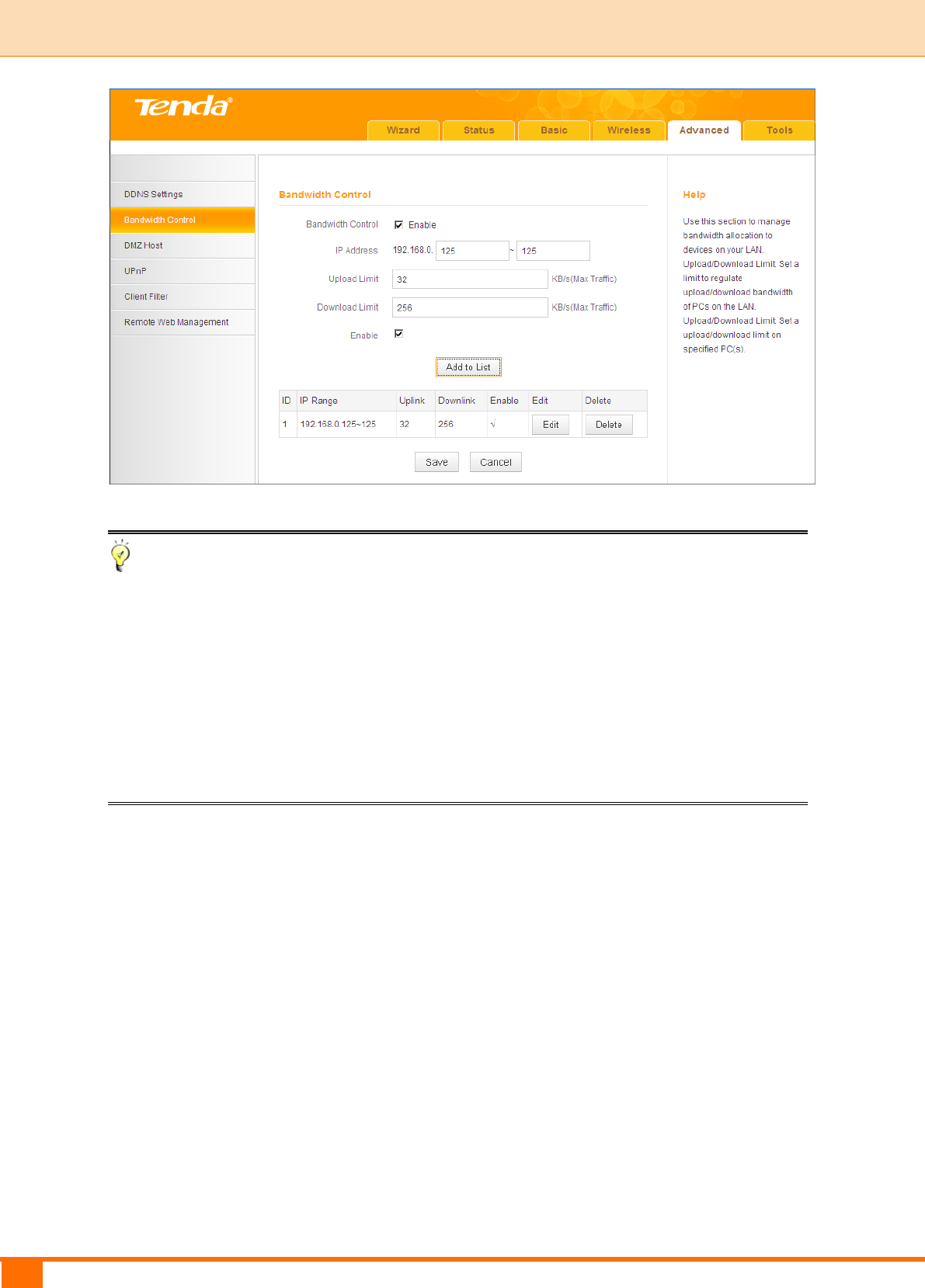
55
III Features & Configurations | Tenda
Tip
① 1M=128KByte/s.
② The volume of uplink traffic/downlink traffic should not be larger than that
allowed on your device's WAN (Internet) port. Consult your ISP, if you are
not sure of the total volume of Internet traffic that you can have.
③ The bandwidth for ADSL/DSL line usually refers to the download bandwidth.
4.6 Client Filter (Available only in 4G600)
This section allows you to set the times specific clients can or cannot access
the Internet via the devices’ IP addresses and service port. Note that this
feature is unavailable in 3G/4G Router Mode.
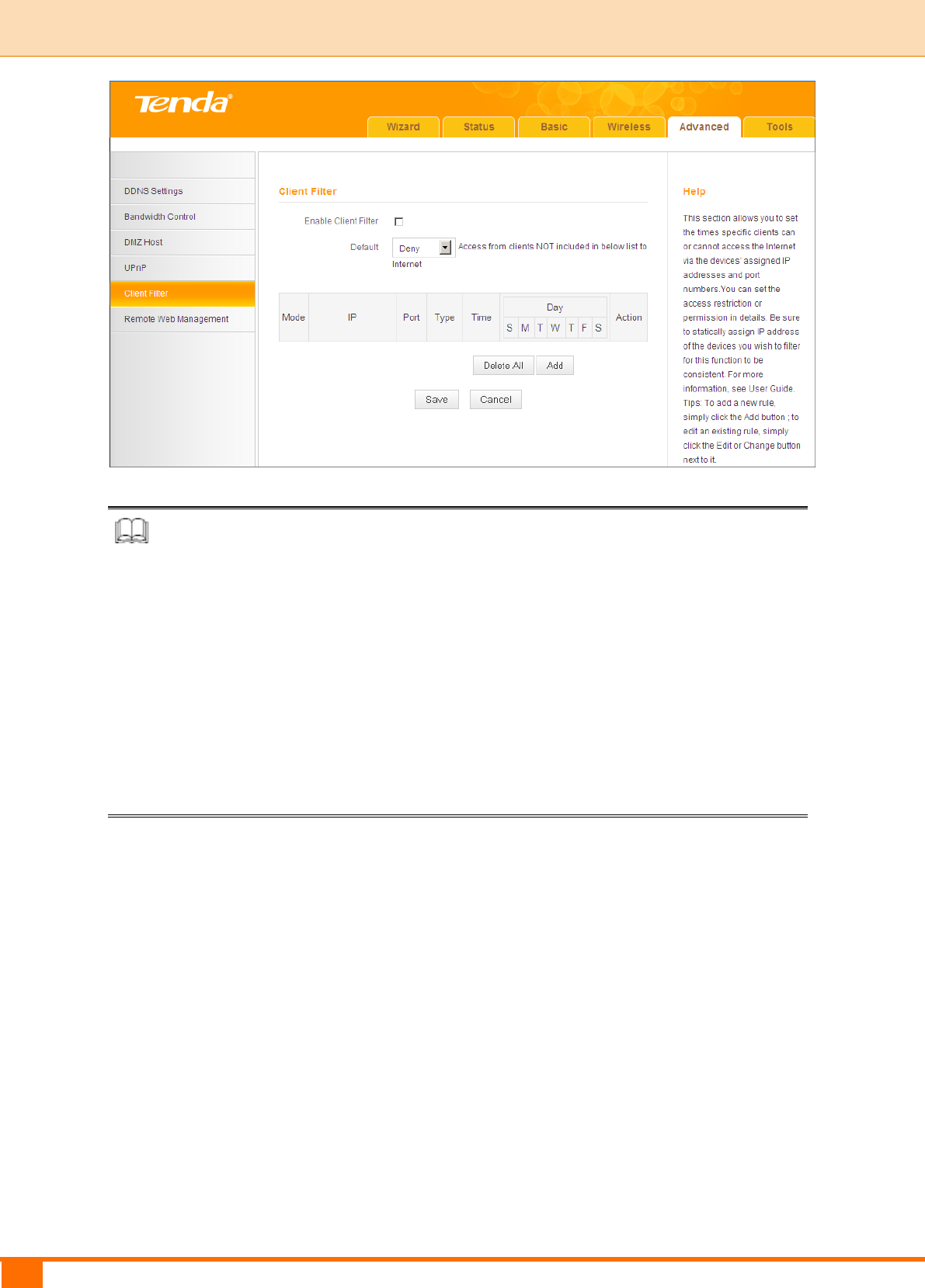
56
III Features & Configurations | Tenda
Knowledge Center
Default: The default policy for the client filter. For the packets that do not match
the set rule, the default rule is applied.
Filter Mode: Specify a filter mode for the rule.
Deny: Disallow the packets that match the set rule to pass the router. For
other packets that do not match the set rule, the default policy is applied.
Allow: Allow the packets that match the set rule to pass the router. For other
packets that do not match the set rule, the default policy is applied.
Client Filter Application Example:
To prohibit PCs within the IP address range of 192.168.0.110--192.168.0.111
from accessing Web pages during the time period of 8:00~18:00 from Monday to
Friday, follow the steps below:
① Click Add to add a filter rule.
② Filter Mode: Select Deny.
③ Description: Briefly describe the current rule. This field is optional.
④ IP: Enter 192.168.0.110 as the starting IP address and 192.168.0.111 as the
ending IP address.
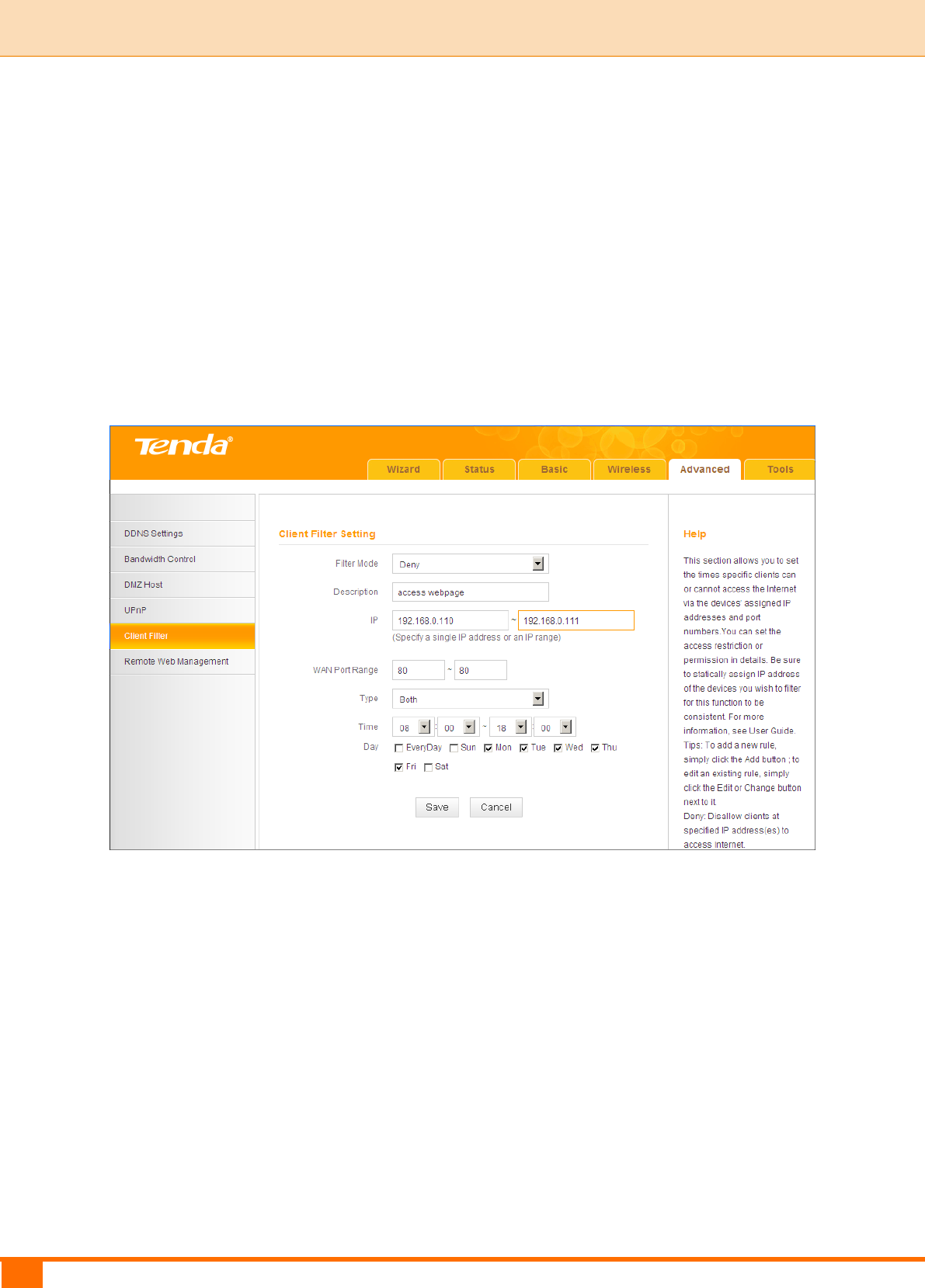
57
III Features & Configurations | Tenda
⑤ WAN Port Range: Enter a service port number. Here in this example, enter
80 in both boxes. HTTP port 80 is the standard protocol for Web servers.
⑥ Type: Select a protocol for the traffic. If you are unsure, select Both.
⑦ Time: Specify a time period for the current rule to take effect. Here in this
example, select 8:00~18:00.
Day: Select a day, or several days of the week for the current rule to take
effect. Here in this example, select Mon, Tue, Wed, Thur and Fri.
⑧ Click Save to save your settings.
⑨ Enable Client Filter: Check to enable the client filter feature.
⑩ Select Allow from the Default drop-down list and then click Save.
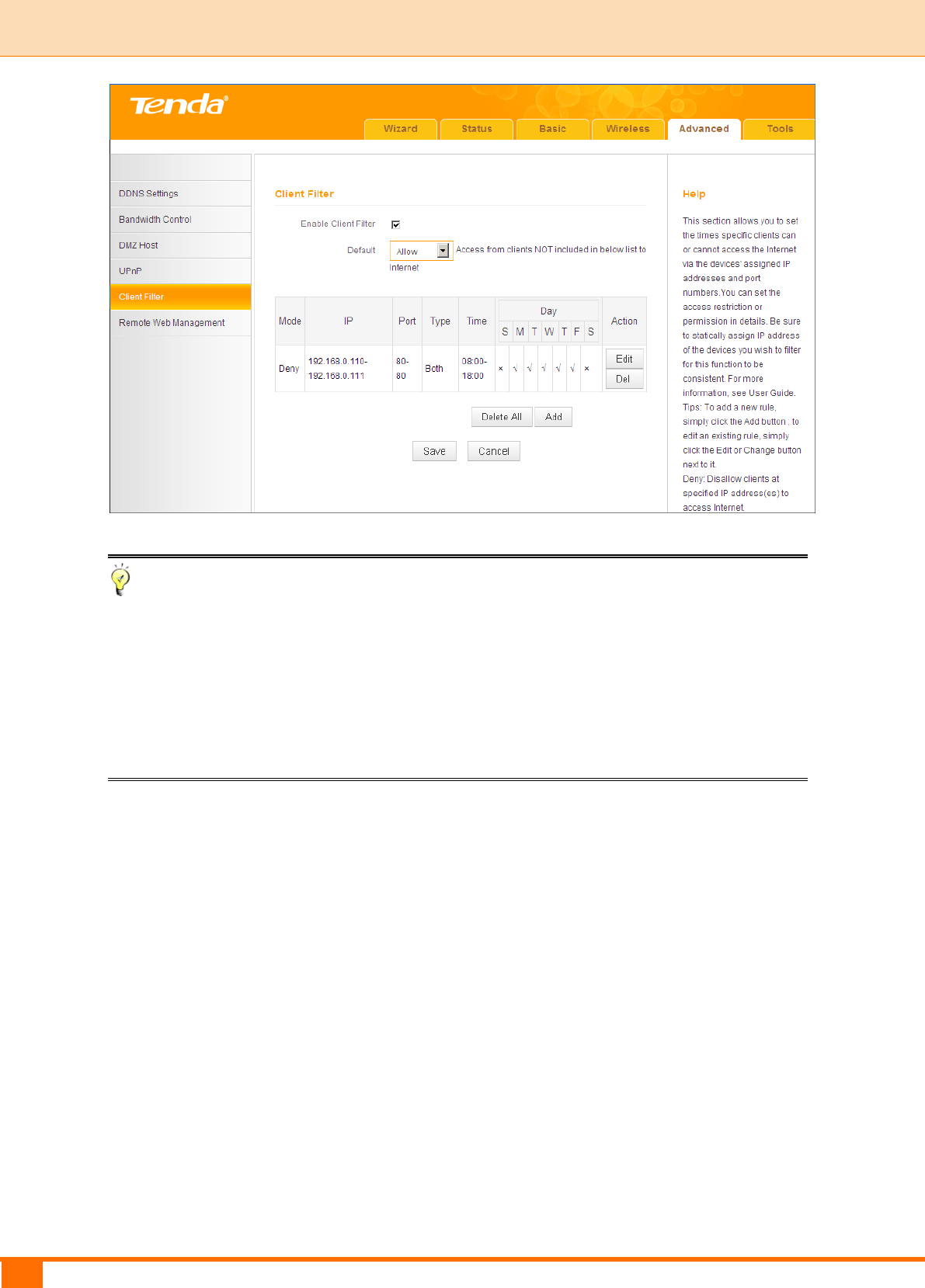
58
III Features & Configurations | Tenda
Tip
① The valid service port number range is 1 ~ 65535.
② If you have not set up the system time for this device, click Tools -> Time &
Date to configure correct time and date settings for the rule(s) to be
effective.
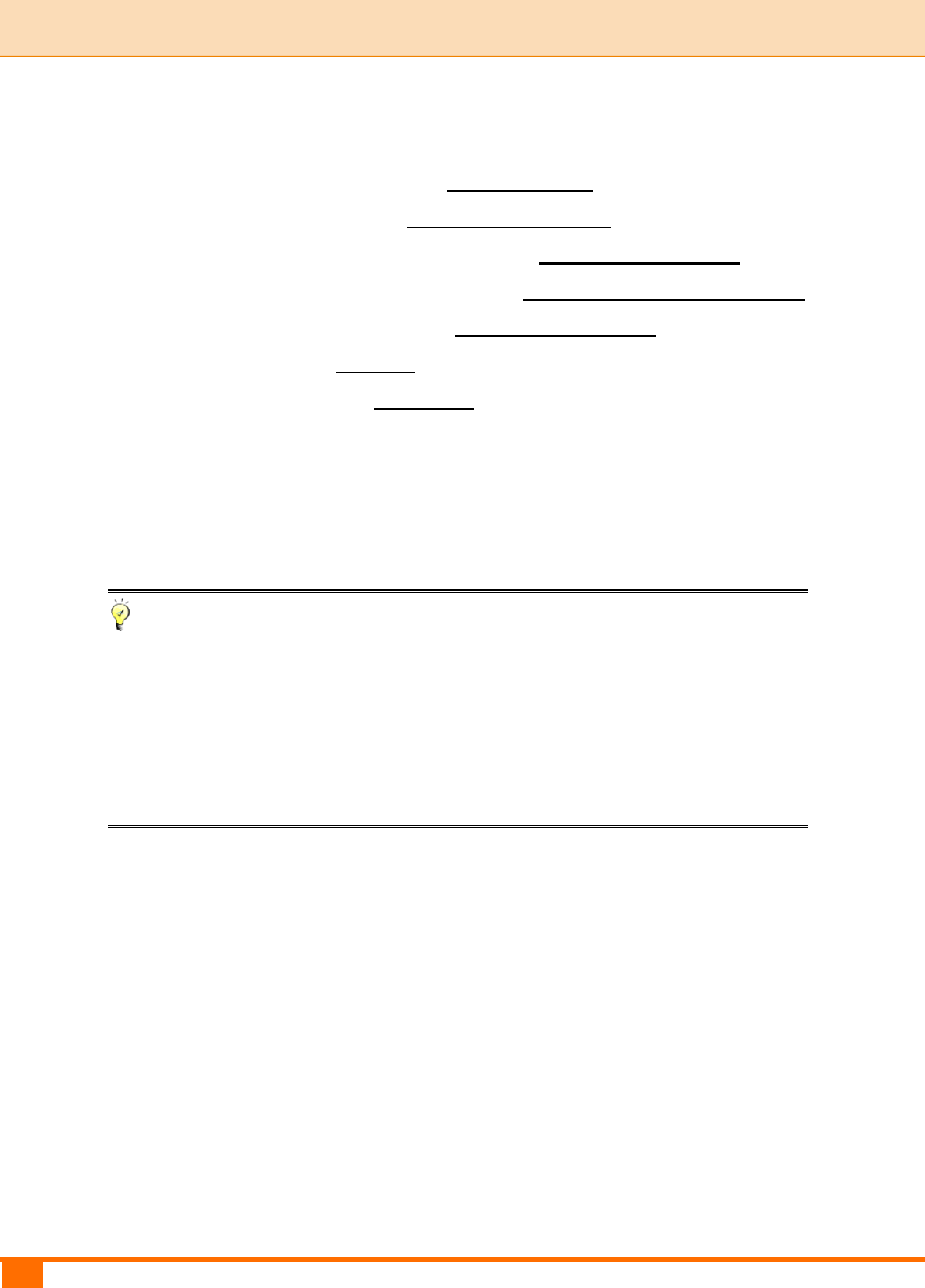
59
III Features & Configurations | Tenda
5 Tools
To configure system time, see 5.1 Time & Date.
To upgrade firmware, see 5.2 Firmware Upgrade.
To backup or restore configurations, see 5.3 Backup & Restore.
To restore factory default settings, see 5.4 Restore to Factory Default.
To change login password, see 5.5 Change Password.
To view logs, see 5.6 Logs.
To restart device, see 5.7 Reboot.
5.1 Time & Date
Click Tools -> Time & Date to enter the configuration screen.
Tip
Configured time and date settings will be lost if the device gets disconnected
from power supply. However, it will be updated automatically when the device
reconnects to the Internet. To activate time-based features (e.g. Client Filter),
the time and date settings should be set correctly first, either manually or
automatically.
A. To synchronize with Internet time servers:
① Internet Time Server: Check to enable the feature (If enabled, time and date
will be updated automatically from the Internet).
② Sync Interval: Specify a time interval for periodic update of time and date
information from the Internet.
③ Time Zone: Select your current time zone.
④ Click Save to save your settings.
⑤ Go to the Status screen to make sure the system time is correctly updated.
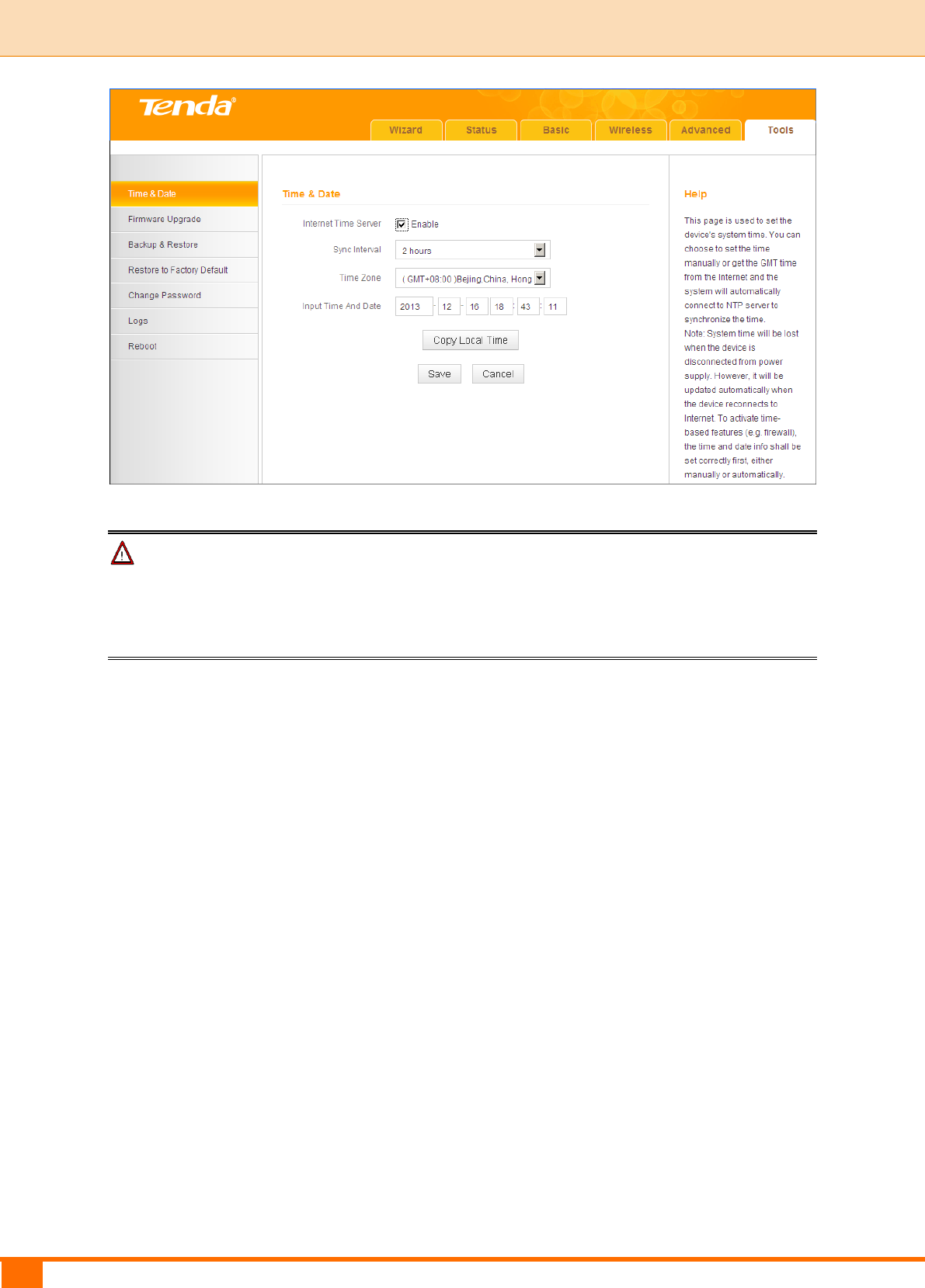
60
III Features & Configurations | Tenda
Note
In the Universal Repeater Mode, the Internet Time Server - Enable feature is
not available, so you can only set the time and date manually.
B. To set time and date manually/synchronize with your PC:
① Internet Time Server: Uncheck to disable the feature.
② Specify the time and date manually or click Copy Local Time to
automatically copy your PC's time to the device.
③ Click Save to save your settings.
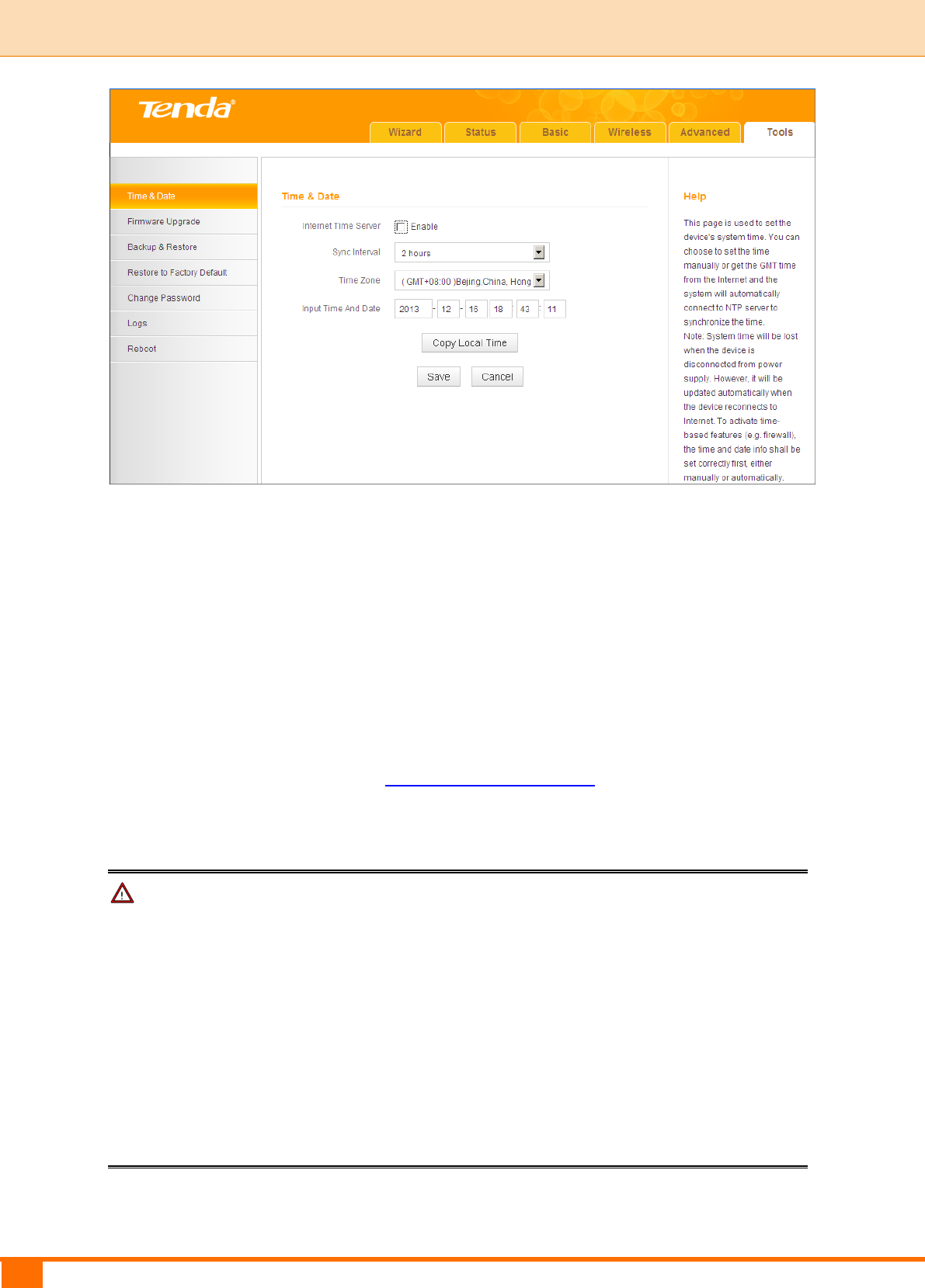
61
III Features & Configurations | Tenda
④ Go to the Status screen to make sure the system time is correctly updated.
5.2 Firmware Upgrade
Click Tools -> Firmware Upgrade to enter the configuration screen. Firmware
upgrade is released periodically to improve the functionality of your device and
also to add new features. If you run into a problem with a specific feature of th e
device, log on to our Website (http://www.tendacn.com) to download the latest
firmware to update your device.
Note
① Before you upgrade the firmware, make sure you are having a correct
firmware. A wrong firmware may damage the device.
② It is advisable that you upgrade the device's firmware over a wired
connection. DO NOT disconnect the power connection to the device when
the upgrade is in process otherwise the router may be permanently
damaged.
Configuration Procedures:
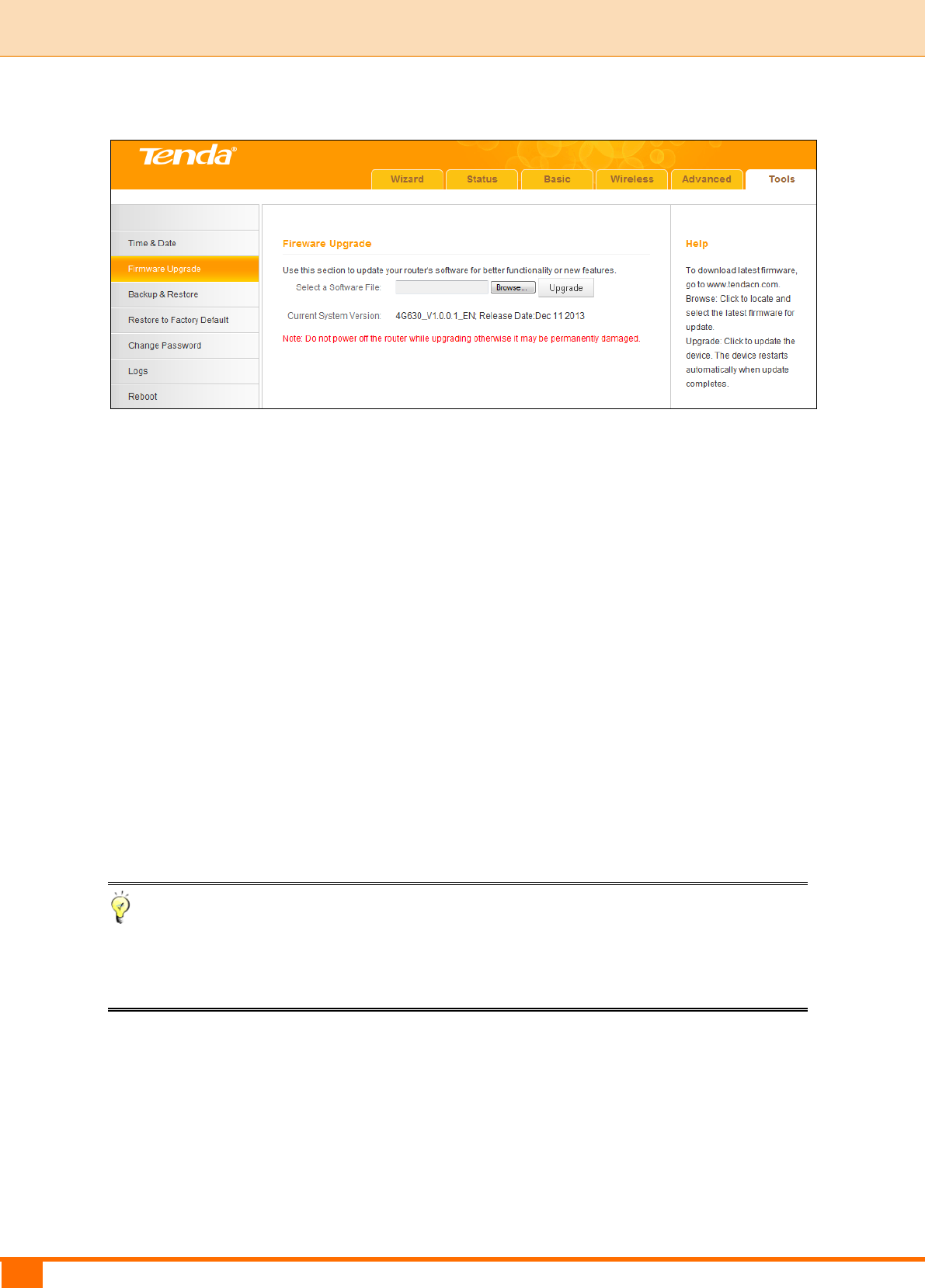
62
III Features & Configurations | Tenda
① Click Browse.
② Select the firmware file you want to use and click Open.
③ Click Upgrade.
④ Click OK on the appearing screen and wait for it to complete.
When upgrade is completed, check the Current System Version field. It should
display the firmware you load.
5.3 Backup & Restore
Once you have configured the device the way you want it, you can save these
settings to a configuration file on your local hard drive that can later be imported
to your device in case that the device is restored to factory default settings.
Click Tools -> Backup & Restore to enter the configuration screen.
Tip
It is advisable to include the file name suffix of ".cfg" to avoid problems when
renaming the file name.
To backup configurations:
① Click Backup.
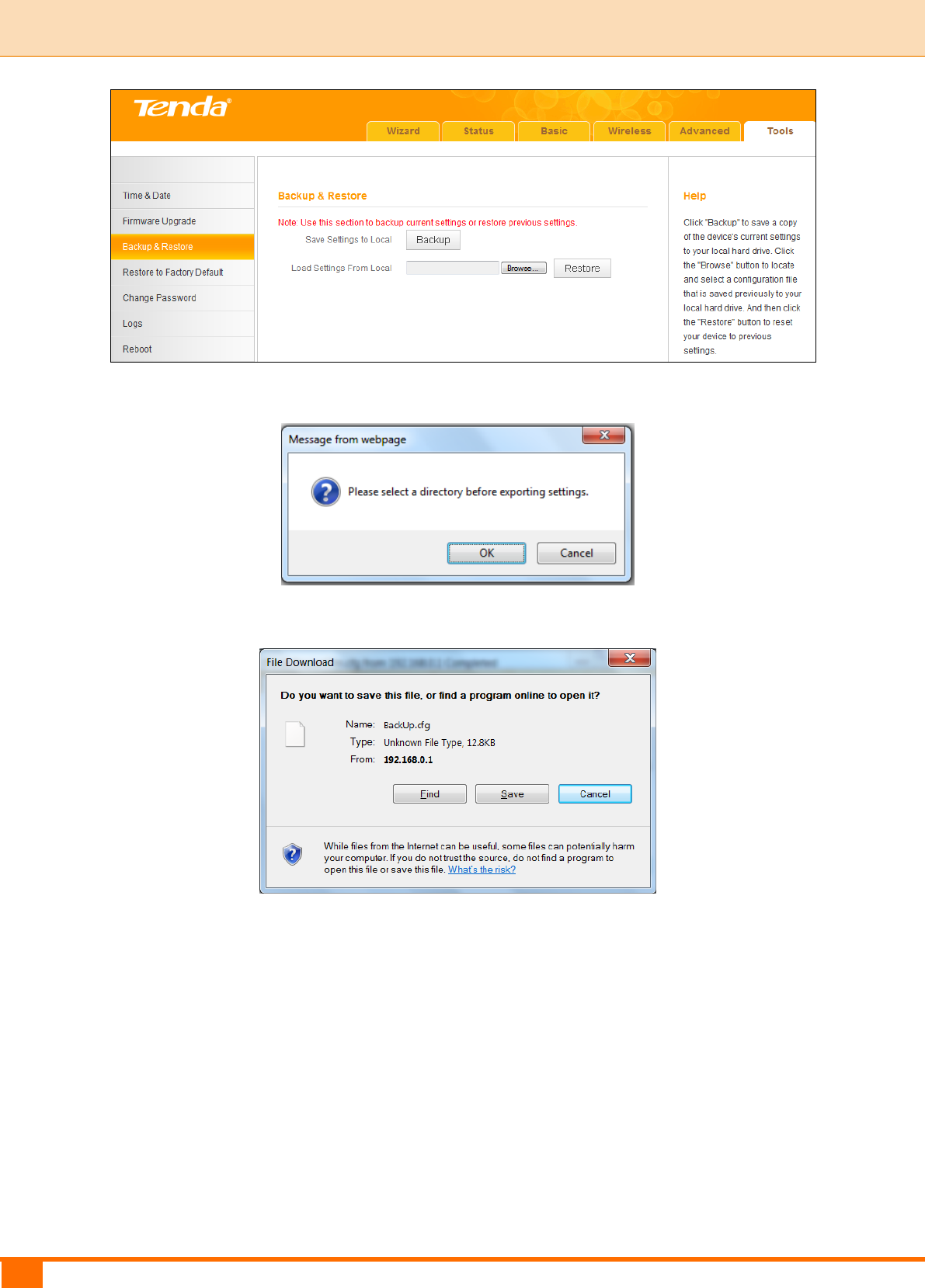
63
III Features & Configurations | Tenda
② Click OK on the appearing window.
③ Click Save on the File Download window.
④ Select a local hard drive to save the file and click Save.
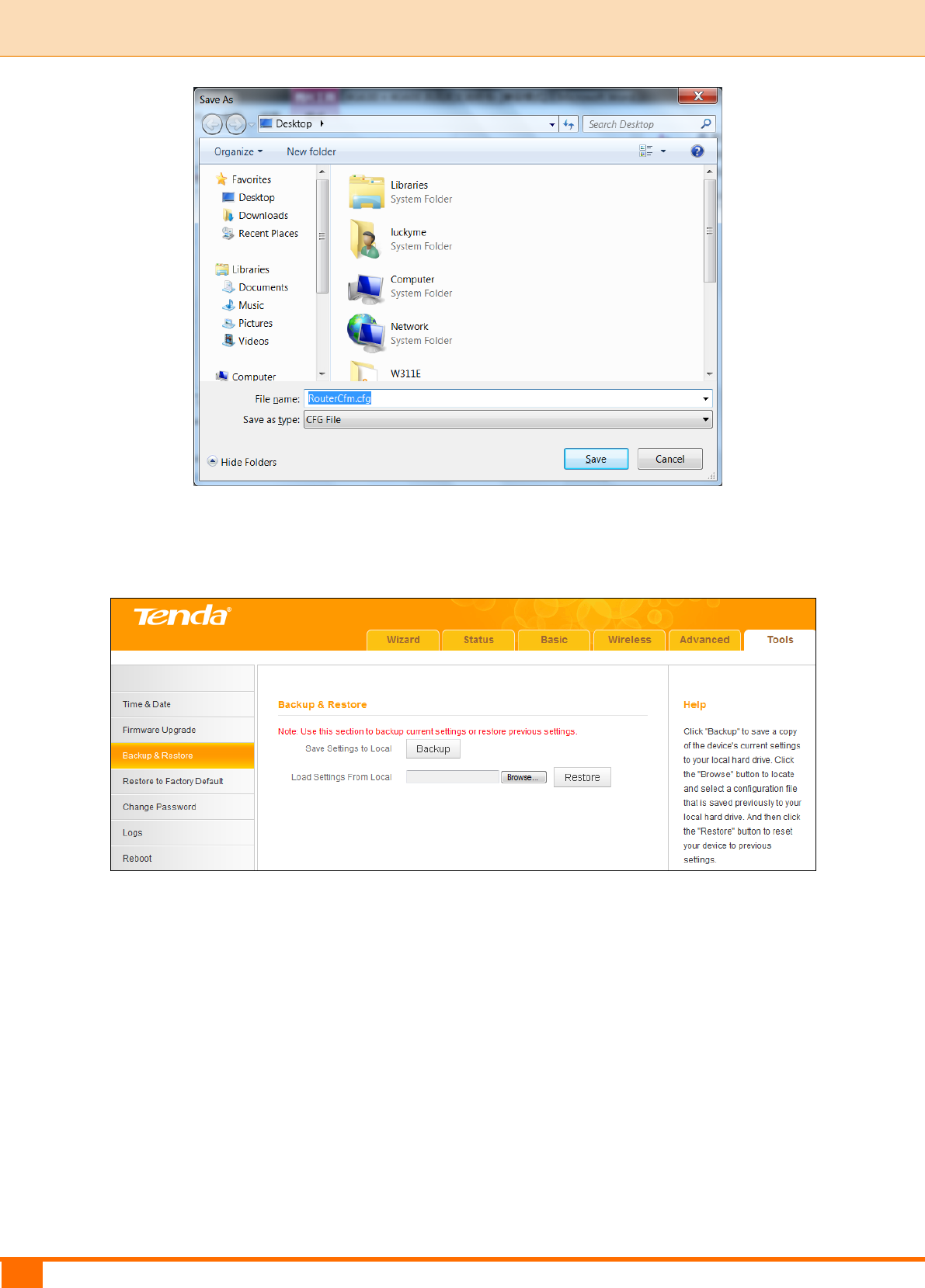
64
III Features & Configurations | Tenda
To restore configurations:
① Click Browse.
② Select the configuration file that is saved previously to your local hard drive
and click Open.

65
III Features & Configurations | Tenda
③ Click the Restore button to reset your device to previous settings.
5.4 Restore to Factory Default
Click Tools -> Restore to Factory Default to enter the configuration screen.
Here you can reset the device to factory default settings.
Note
① If you enable this option, the device will be restored to factory default values.
You will have to reconfigure Internet connection settings and wireless
settings.
② Do not restore factory default settings unless the following happens:
You need to join a different network or unfortunately forget the login
password.
You cannot access the Internet and your ISP or our technical support asks

66
III Features & Configurations | Tenda
you to reset the device.
The factory default settings are listed below:
IP Address: 192.168.0.1
Subnet Mask: Enter 255.255.255.0.
Password: admin
5.5 Change Password
Click Tools -> Change Password to enter the configuration screen. It is
strongly recommended that you change the factory default login password.
Otherwise, anyone in your network can access this utility to change your
settings.
Tip
① The default login password is "admin".
② A valid password must only include letters, numbers or underscore.
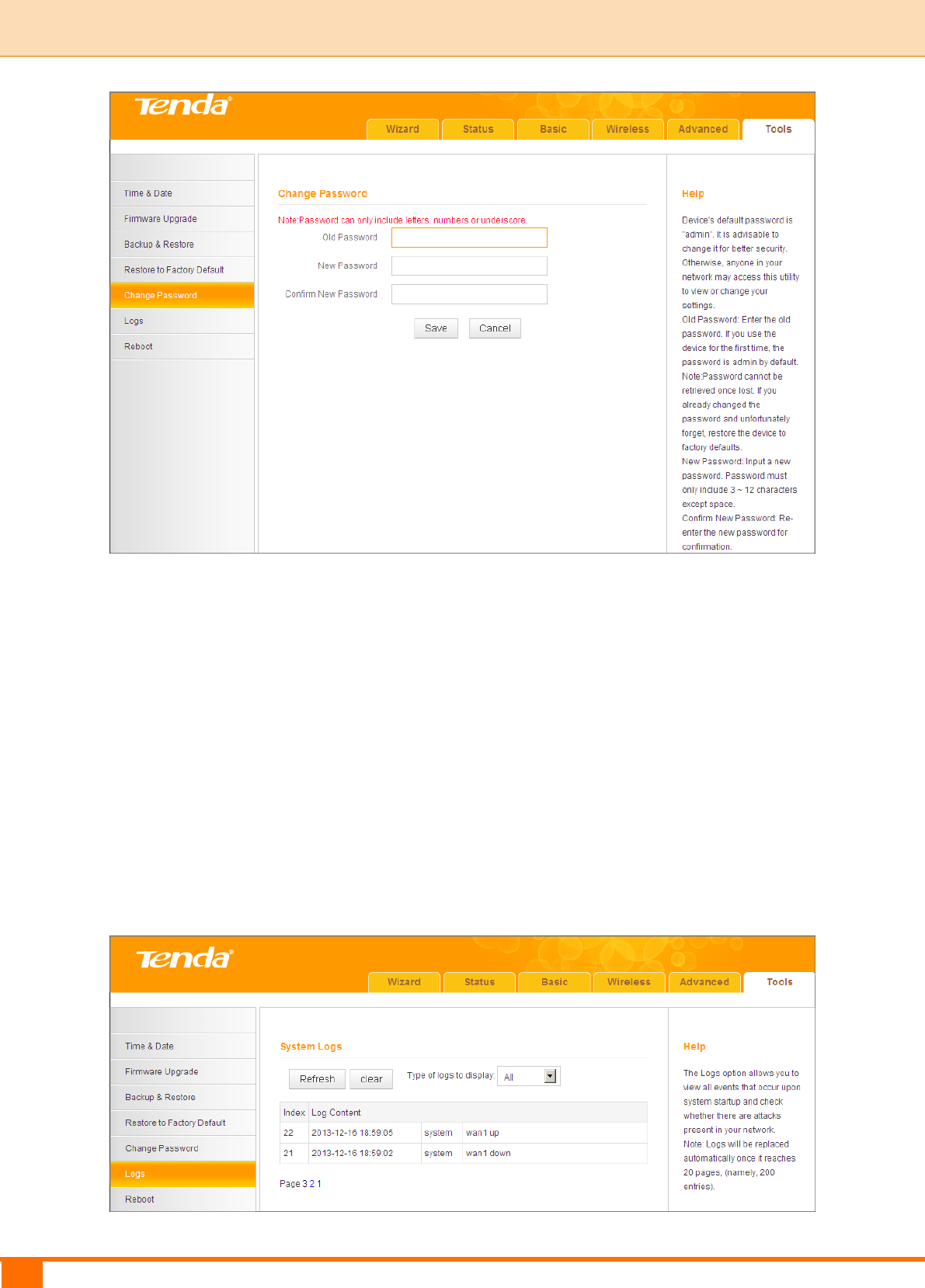
67
III Features & Configurations | Tenda
Configuration Procedures:
① Old Password: Enter the current login password.
② New Password: Input a new password.
③ Confirm New Password: Re-enter the new password for confirmation.
④ Click Save to save your settings.
5.6 Logs
Click Tools -> Logs to enter the configuration screen. Here you can view the
history of the device’s actions upon system startup.
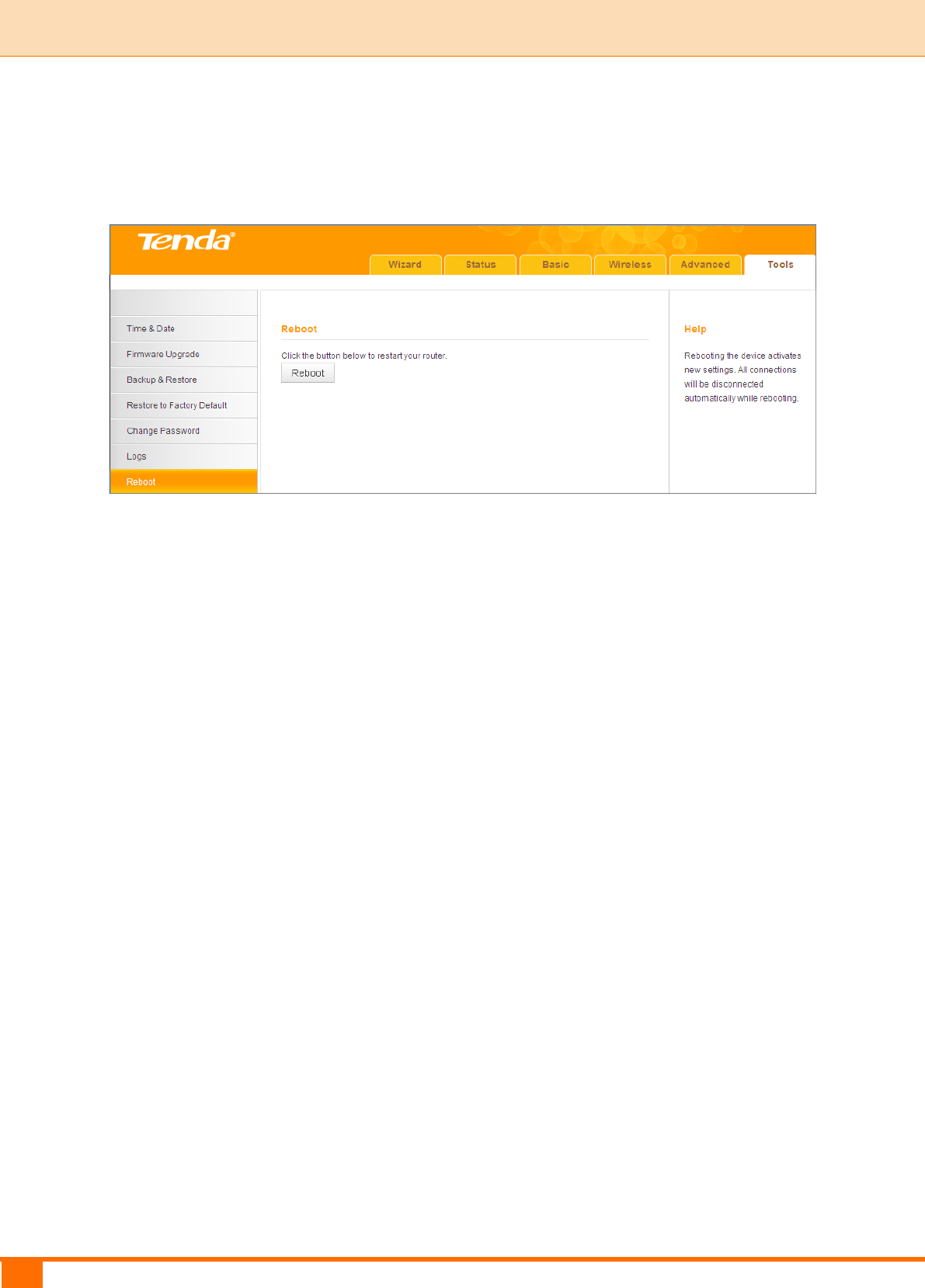
68
III Features & Configurations | Tenda
5.7 Reboot
When a certain feature does not take effect or the device is malfunctioning, try
rebooting the device.
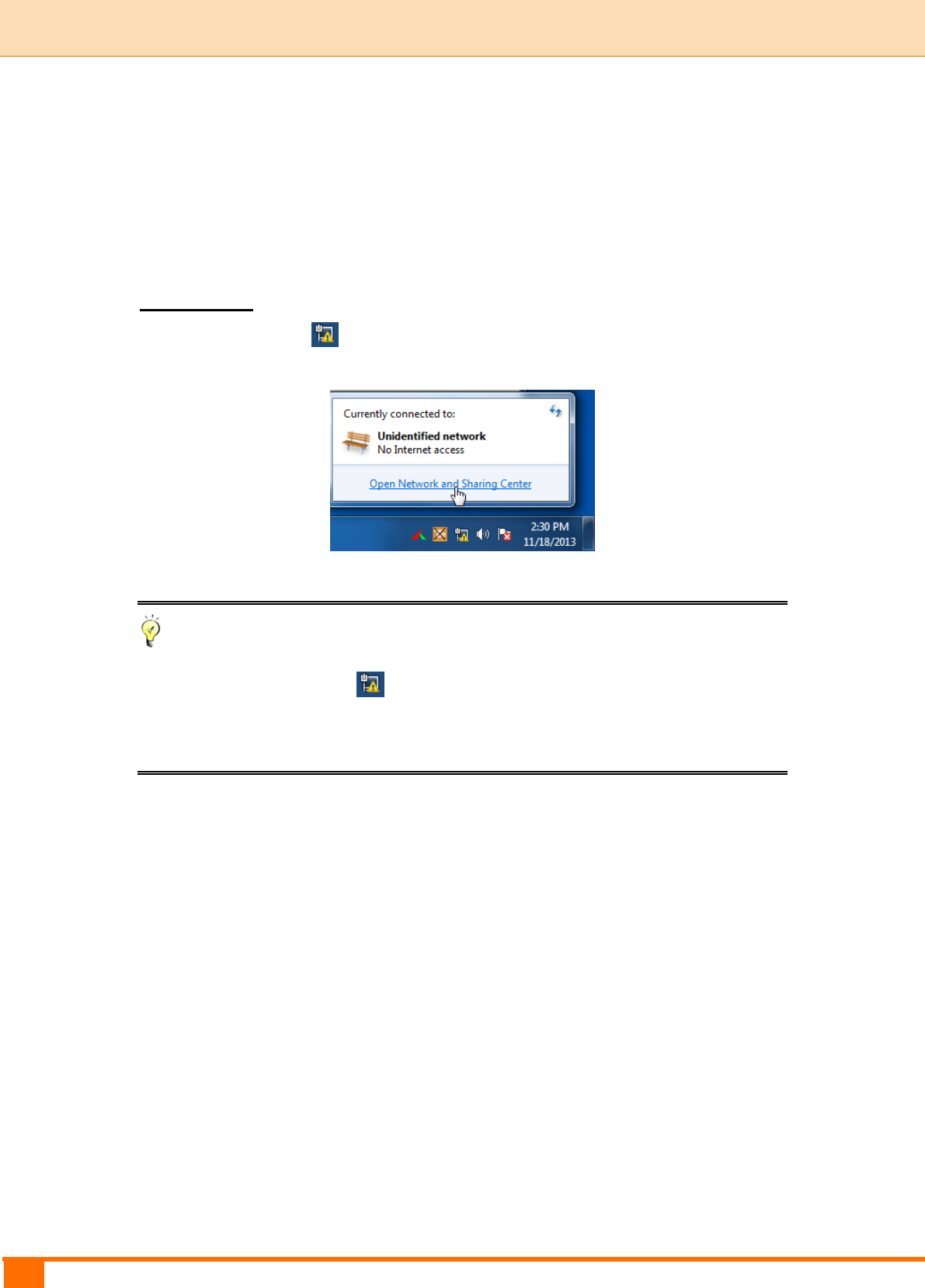
69
IV Appendix | Tenda
IV Appendix
1 Configure Your PC
Windows 7
Step 1: Click the icon on the right bottom corner of your desktop.
Step 2: Click Open Network and Sharing Center.
Tip
If you cannot find the icon on the right bottom corner of your desktop, follow
steps below: Click Start -> Control Panel -> Network and Internet -> Network and
Sharing Center.

70
IV Appendix | Tenda
Step 3: Click Local Area Connection -> Properties.
Step 4: Find and double click Internet Protocol Version 4(TCP/IPv4).

71
IV Appendix | Tenda
Step 5: Select Obtain an IP address automatically and Obtain DNS server
address automatically and click OK.
Step 6: Click OK on the Local Area Connection Properties window (see Step 4 for
the screenshot).
Windows XP
Step 1: Right click My Network Places on your desktop and select Properties.

72
IV Appendix | Tenda
Step 2: Right click Local Area Connection and select Properties.
Step 3: Scroll down to find and double click Internet Protocol (TCP/IP).

73
IV Appendix | Tenda
Step 4: Select Obtain an IP address automatically and Obtain DNS server
address automatically and click OK.
Step 5: Click OK on the Local Area Connection Properties window (see Step 3 for
the screenshot).

74
IV Appendix | Tenda
2 Join Your Wireless Network
Tip
① To join your wireless network, the PC you use must have an installed wireless
network adapter. If not, install one.
② The device’s SSID is "Tenda_XXXXXX" by default (where "XXXXXX" is the last
six characters of its MAC address). You can find the MAC address and/or SSID
on the label attached to the device’s bottom).
Windows 7
Step 1: Click or from the right bottom of your desktop.
Step 2: Double click the name of the wireless network (SSID) you wish to join and
then follow onscreen instructions.
When Connected appears next to the selected wireless network (SSID), you have
successfully connected to it.

75
IV Appendix | Tenda
Windows XP
Step 1: Right click My Network Places and select Properties.
Step 2: Right click Wireless Network Connection and select View Available
Wireless Networks.

76
IV Appendix | Tenda
Step 3: Double click the name of the wireless network (SSID) you wish to join and
then follow onscreen instructions.
When Connected appears next to the selected wireless network (SSID), you have
successfully connected to it.

77
IV Appendix | Tenda

78
IV Appendix | Tenda
3 FAQs
This section provides solutions to problems that may occur during installation and
operation of the device. Read the following if you are running into problems.
If your problem is not covered here, please feel free to go to www.tendacn.com to find
a solution or email your problems to: support@tenda.com.cn or
support02@tenda.com.cn. We will be more than happy to help you out as soon as
possible.
1. Q: I cannot access the device's management interface. What should I do?
Make sure the PWR (power) LED on the device is on and the SYS LED blinks
normally.
Make sure all cables are correctly connected and the corresponding LAN LED on
the device is on.
Verify that your PC's TCP/IP settings are configured correctly. If you select the
"Use the following IP address" option, set your PC's IP address to any IP address
between 192.168.0.2~192.168.0.254. Or you can select the "Obtain an IP
address automatically" option.
Delete your browser cache and cookies or use a new browser. Make sure you
enter 192.168.0.1 in your browser’s address bar.
Open your browser and click Tools -> Internet Options -> Connections -> LAN
Settings, uncheck the Use a proxy server for your LAN option.
Press the WPS/Reset button for over 6 seconds to restore your device to factory
default settings. Then log in to your device again.
2. Q: I changed the login password and unfortunately forget it. What should I
do?
Press the WPS/Reset button for over 6 seconds to restore your device to factory
default settings.
3. Q: My computer shows an IP address conflict error when it connects to the

79
IV Appendix | Tenda
device. What should I do?
Make sure there are no other DHCP servers on your LAN or other DHCP servers
are disabled.
Make sure the device's LAN IP is not used by other devices on your LAN. The
device's default LAN IP address is 192.168.0.1.
Make sure the statically assigned IP addresses to the PC(s) on LAN are not used
by others device(s).
4. Q: I cannot access email and the Internet/Some Websites do not open. What
should I do?
This problem mainly happens to users who use the PPPoE or Dynamic IP Internet
connection type. You need to change the MTU size. Try changing the MTU to 1450 or
1400. If this does not help, gradually reduce the MTU from the maximum value until the
problem disappears. For details, see WAN MTU Setup.

80
IV Appendix | Tenda
4 Remove Wireless Network from Your PC
When you change your wireless network (For example, change your device's SSID or
security key), the old wireless settings on your PC will not be updated accordingly, you
must manually remove them from your PC; otherwise, you may not be able to
wirelessly connect to the device. This section explains how to remove a wireless
network from your PC.
Windows 7
① Right-click the Network icon and select Properties.
② Select Manage Wireless Networks.
③ Select the wireless network and click Remove network.

81
IV Appendix | Tenda
Windows XP
① Right-click My Network Places and select Properties.
② Right click Wireless Network Connection and then select Properties.

82
IV Appendix | Tenda
③ Click Wireless Networks, select the wireless network name under Preferred
networks and then click the Remove button.

83
IV Appendix | Tenda
5 Safety and Emission Statement
CE Mark Warning
This is a Class B product. In a domestic environment, this product may cause radio
interference, in which case the user may be required to take adequate measures. This
device complies with EU 1999/5/EC.
NOTE: (1) The manufacturer is not responsible for any radio or TV interference
caused by unauthorized modifications to this equipment. (2) To avoid unnecessary
radiation interference, it is recommended to use a shielded RJ-45 cable.
FCC Statement
This device complies with Part 15 of the FCC Rules. Operation is subject to the
following two conditions: (1) This device may not cause harmful interference, and (2)
this device must accept any interference received, including interference that may
cause undesired operation.
This equipment has been tested and found to comply with the limits for a Class B
digital device, pursuant to Part 15 of the FCC Rules. These limits are designed to
provide reasonable protection against harmful interference in a residential installation.
This equipment generates, uses and can radiate radio frequency energy and, if not
installed and used in accordance with the instructions, may cause harmful
interference to radio communications. However, there is no guarantee that
interference will not occur in a particular installation. If this equipment does cause
harmful interference to radio or television reception, which can be determined by
turning the equipment off and on, the user is encouraged to try to correct the
interference by one of the following measures:
- Reorient or relocate the receiving antenna.

84
IV Appendix | Tenda
- Increase the separation between the equipment and receiver.
- Connect the equipment into an outlet on a circuit different from that to which the
receiver is connected.
- Consult the dealer or an experienced radio/TV technician for help.
FCC Caution: Any changes or modifications not expressly approved by the party
responsible for compliance could void the user's authority to operate this equipment.
This transmitter must not be co-located or operating in conjunction with any other
antenna or transmitter.
The manufacturer is not responsible for any radio or TV interference caused by
unauthorized modifications to this equipment.
Radiation Exposure Statement
This equipment complies with FCC radiation exposure limits set forth for an
uncontrolled environment. This equipment should be installed and operated with
minimum distance 20cm between the radiator & your body.
NOTE: (1) The manufacturer is not responsible for any radio or TV interference
caused by unauthorized modifications to this equipment. (2) To avoid unnecessary
radiation interference, it is recommended to use a shielded RJ-45 cable.
NCC Notice
經型式認證合格之低功率射頻電機,非經許可,公司、商號或使用者均不得擅自變更
頻率、加大功率或變更設計之特性及功能。
低功率射頻電機之作用不得影響飛航安全及幹擾合法通信;經發現有幹擾現象時,應
立即停用,並改善至無幹擾時方得繼續使用。前項合法通信,指依電信規定作業之無
線電信。低功率射頻電機須忍受合法通信或工業、科學及醫療用電波輻射性電機設備
之幹擾。